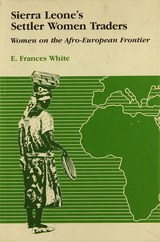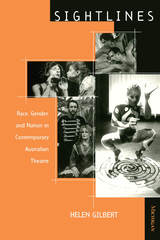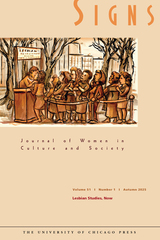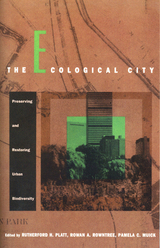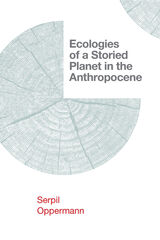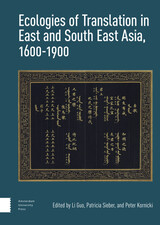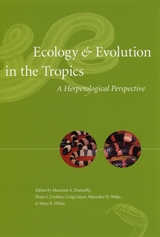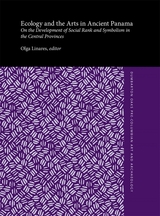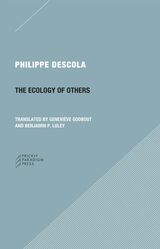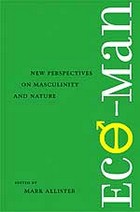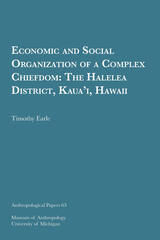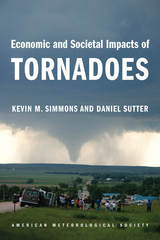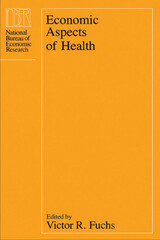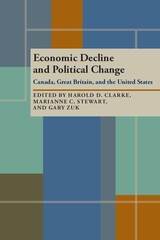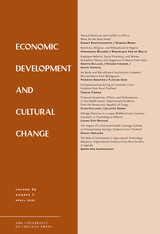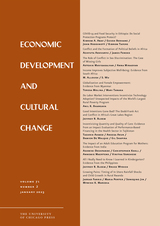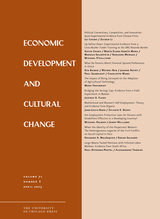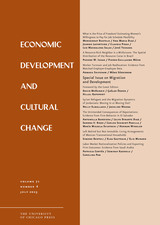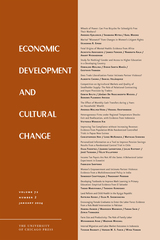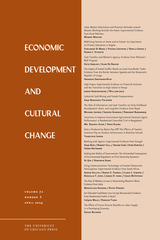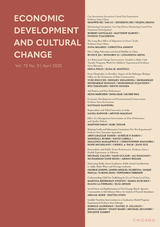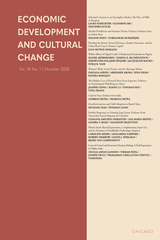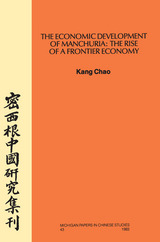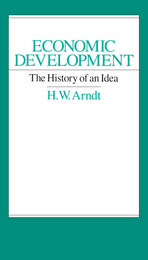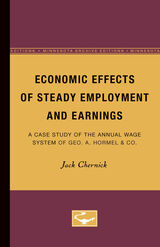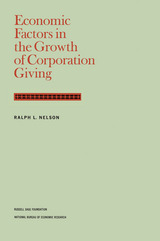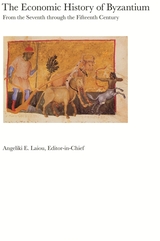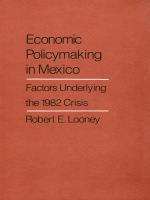 Eclogues. Garden of the Hesperides
Giovanni Gioviano Pontano
Harvard University Press, 2022 A renowned Renaissance poet’s homage to Naples makes its debut in modern English translation.
Giovanni Pontano (1429–1503), whose academic name was Gioviano, was one of the great scholar-poets of the Renaissance as well as a leading statesman who served as prime minister to the Aragonese kings of southern Italy. The dominant literary figure of quattrocento Naples, Pontano produced literary works in several genres and was the leader of the Neapolitan academy. The two works included in the present volume, broadly inspired by Virgil, might be considered Pontano’s love songs to the landscapes of Naples. The Eclogues offer a spectacular, panoramic tour of the Bay of Naples region, even as they focus on intimate domestic scenes and allegorize the people and places of the poet’s world. The Garden of the Hesperides is a work of brilliant erudition on an unprecedented poetic topic: the cultivation of citrus trees and the splendid pleasures of gardens. This volume features a newly established Latin text of the Garden of the Hesperides as well as the first published translations of both works into English.
 Eclogues. Georgics. Aeneid, Books 1–6
Virgil
Harvard University Press, 1999 “The classic of all Europe.” —T. S. Eliot
Virgil (Publius Vergilius Maro) was born in 70 BC near Mantua and was educated at Cremona, Milan, and Rome. Slow in speech, shy in manner, thoughtful in mind, weak in health, he went back north for a quiet life. Influenced by the group of poets there, he may have written some of the doubtful poems included in our Virgilian manuscripts. All his undoubted extant work is written in his perfect hexameters. Earliest comes the collection of ten pleasingly artificial bucolic poems, the Eclogues, which imitated freely Theocritus’ idylls. They deal with pastoral life and love. Before 29 BC came one of the best of all didactic works, the four books of Georgics on tillage, trees, cattle, and bees. Virgil’s remaining years were spent in composing his great, not wholly finished, epic the Aeneid, on the traditional theme of Rome’s origins through Aeneas of Troy. Inspired by the Emperor Augustus’ rule, the poem is Homeric in metre and method but influenced also by later Greek and Roman literature, philosophy, and learning, and deeply Roman in spirit. Virgil died in 19 BC at Brundisium on his way home from Greece, where he had intended to round off the Aeneid. He had left in Rome a request that all its twelve books should be destroyed if he were to die then, but they were published by the executors of his will.
The Loeb Classical Library edition of Virgil is in two volumes.
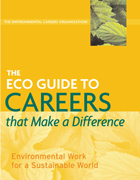 The ECO Guide to Careers that Make a Difference: Environmental Work For A Sustainable World
Environmental Careers Organization
Island Press, 2005 How can you make a real difference in the world and make a good living at the same time? The ECO Guide to Careers That Make a Difference: Environmental Work for a Sustainable World provides the answer.
Developed by The Environmental Careers Organization (ECO, the creators of the popular Complete Guide to Environmental Careers), this new volume is unlike any careers book you've seen before. Reaching far beyond job titles and resume tips, The ECO Guide immerses you in the strategies and tactics that leading edge professionals are using to tackle pressing problems and create innovative solutions.
To bring you definitive information from the real world of environmental problem-solving, The ECO Guide has engaged some of the nation's most respected experts to explain the issues and describe what's being done about them today. You'll explore: Global climate change with Eileen Claussen, Pew Center for Global Climate Change; Biodiversity loss with Stuart Pimm, Nicholas School for the Environment at Duke University; Green Business with Stuart Hart, Kenan-Flager Business School at University of North Carolina; Ecotourism with Martha Honey, The International Ecotourism Society; Environmental Justice with Robert Bullard, Environmental Justice Center at Clark Atlanta University; Alternative Energy with Seth Dunn, Worldwatch Institute; Water Quality with Sandra Postel, Global Water Policy Project; Green Architecture with William McDonough, McDonough + Partners; and twelve other critical issues.
To demonstrate even more clearly what eco-work feels like on the ground, The ECO Guide offers vivid "Career Snapshots" of selected employers and the professionals that work there. You'll visit government agencies like the USDA Forest Service, nonprofit organizations like Conservation International and Project Wild, and local advocates like Alternatives for Community and Environment. You'll go inside environmental businesses like Wildland Adventures and Stonyfield Farms. And you'll learn from academic institutions like the National Center for Atmospheric Research and the Gund Institute for Ecological Economics.
ECO also identifies and describes forty specific jobs that are representative of environmental career opportunities in the twenty-first century. It provides dozens of the best Internet resources. And most importantly, The ECO Guide offers all of the insight about current trends you expect from ECO, the acknowledged leaders in environmental career information.
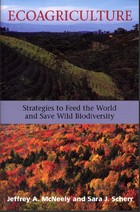 Ecoagriculture: Strategies to Feed the World and Save Wild Biodiversity
Future Harvest, Jeffrey A. McNeely, and Sara J. Scherr
Island Press, 2002 Although food-production systems for the world's rural poor typically have had devastating effects on the planet's wealth of genes, species, and ecosystems, that need not be the case in the future. In Ecoagriculture, two of the world's leading experts on conservation and development examine the idea that agricultural landscapes can be designed more creatively to take the needs of human populations into account while also protecting, or even enhancing, biodiversity. They present a thorough overview of the innovative concept of "ecoagriculture" - the management of landscapes for both the production of food and the conservation of wild biodiversity. The book: - examines the global impact of agriculture on wild biodiversity
- describes the challenge of reconciling biodiversity conservation and agricultural goals
- outlines and discusses the ecoagriculture approach
- presents diverse case studies that illustrate key strategies
- explores how policies, markets, and institutions can be re-shaped to support ecoagriculture
While focusing on tropical regions of the developing world -- where increased agricultural productivity is most vital for food security, poverty reduction, and sustainable development, and where so much of the world's wild biodiversity is threatened -- it also draws on lessons learned in developed countries. Dozens of examples from around the world present proven strategies for small-scale, low-income farmers involved in commercial production. Ecoagriculture explores new approaches to agricultural production that complement natural environments, enhance ecosystem function, and improve rural livelihoods. It features a wealth of real-world case studies that demonstrate the applicability of the ideas discussed and how the principles can be applied, and is an important new work for policymakers, students, researchers, and anyone concerned with conserving biodiversity while sustaining human populations.
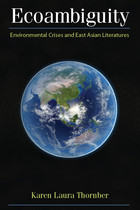 Ecoambiguity: Environmental Crises and East Asian Literatures
Karen Laura Thornber
University of Michigan Press, 2012 East Asian literatures are famous for celebrating the beauties of nature and depicting people as intimately connected with the natural world. But in fact, because the region has a long history of transforming and exploiting nature, much of the fiction and poetry in the Chinese, Japanese, and Korean languages portrays people as damaging everything from small woodlands to the entire planet. These texts seldom talk about environmental crises straightforwardly. Instead, like much creative writing on degraded ecosystems, they highlight what Karen Laura Thornber calls ecoambiguity—the complex, contradictory interactions between people and the nonhuman environment.
Ecoambiguity is the first book in any language to analyze Chinese, Japanese, Korean, and Taiwanese literary treatments of damaged ecosystems. Thornber closely examines East Asian creative portrayals of inconsistent human attitudes, behaviors, and information concerning the environment and takes up texts by East Asians who have been translated and celebrated around the world, including Gao Xingjian, Ishimure Michiko, Jiang Rong, and Ko Un, as well as fiction and poetry by authors little known even in their homelands. Ecoambiguity addresses such environmental crises as deforesting, damming, pollution, overpopulation, species eradication, climate change, and nuclear apocalypse. This book opens new portals of inquiry in both East Asian literatures and ecocriticism (literature and environment studies), as well as in comparative and world literature.
 Ecocide: A Short History of the Mass Extinction of Species
Franz Broswimmer
Pluto Press, 2002 At the dawn of the 21st century, it is clear that changes of enormous ecological significance are occuring on our planet. The ozone layer is beginning to disintegrate. Since 1970 the world's forests have almost halved. A quarter of the world's fish have been depleted. We live in an age of ecocide. 70% of biologists believe the world is now in the midst of the fastest mass extinction of species in the planet's 4.5 billion-year history. Biodiversity loss is rated as a more serious environmental problem than the depletion of the ozone layer, global warming, or pollution and contamination. How have we come to this, and what can be done to conserve our environment for the future? Ecocide: A Short History of the Mass Extinction of Species examines the facts behind the figures to offer a disturbing account of the ecological impact that the human species has on the planet. Research specialist Franz Broswimmer shows how we are wilfully destroying our world. Highlighting important countermovements who are working for ecological democracy, this unique book is essential for anyone who cares about conserving our environment for the future.
 Ecocritique: Contesting the Politics of Nature, Economy, and Culture
Timothy W. Luke
University of Minnesota Press, 1997
Ecocriticism, whether coming from “back to nature” conservatives, Nature Conservancy liberals, or Earth First! radicals, is familiar enough. But when we listen do we really hear what these groups are saying? In a book that examines the terms of ecocriticism, Timothy W. Luke exposes how ecological critics, organizations, and movements manipulate our conception of the environment. Turning the tables on the ecocritics, Luke demonstrates how ecocriticism can move beyond its familiar confines to engage larger cultural, economic, and political questions.
Ecocritique rereads ecocriticism to reveal how power and economy, society and culture, community and technology compete over what are now widely regarded as the embattled ecosystems of nature. Luke considers in particular how the meanings and values attached to the environment by various groups—from the Worldwatch Institute, the Nature Conservancy, and Earth First! to proponents of green consumerism, social ecology, and sustainable development—articulate new visions of power and subjectivity for a post-Cold War era.
This accessibly written work opens with deep ecology and concludes with social ecology, along the way reconsidering thinkers with green philosophical leanings, including Herbert Marcuse, Paolo Soleri, and Murray Bookchin. In systematic critiques reexamining the cultural practices and ethical values of contemporary environmentalism, Luke highlights the political dilemmas of biocentrism and anthropocentrism in modern ecological thinking.
With its critical analysis of many contemporary environmental discourses and organizations, Ecocritique makes a major contribution to ongoing debates about the political relationships among nature, culture, and economics in the current global system.
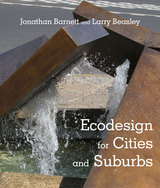 Ecodesign for Cities and Suburbs
Jonathan Barnett and Larry Beasley
Island Press, 2015 As world population grows, and more people move to cities and suburbs, they place greater stress on the operating system of our whole planet. But urbanization and increasing densities also present our best opportunity for improving sustainability, by transforming urban development into desirable, lower-carbon, compact and walkable communities and business centers.
Jonathan Barnett and Larry Beasley seek to demonstrate that a sustainable built and natural environment can be achieved through ecodesign, which integrates the practice of planning and urban design with environmental conservation, through normal business practices and the kinds of capital programs and regulations already in use in most communities. Ecodesign helps adapt the design of our built environment to both a changing climate and a rapidly growing world, creating more desirable places in the process.
In six comprehensively illustrated chapters, the authors explain ecodesign concepts, including the importance of preserving and restoring natural systems while also adapting to climate change; minimizing congestion on highways and at airports by making development more compact, and by making it easier to walk, cycle and take trains and mass transit; crafting and managing regulations to insure better placemaking and fulfill consumer preferences, while incentivizing preferred practices; creating an inviting and environmentally responsible public realm from parks to streets to forgotten spaces; and finally how to implement these ecodesign concepts.
Throughout the book, the ecodesign framework is demonstrated by innovative practices that are already underway or have been accomplished in many cities and suburbs—from Hammarby Sjöstad in Stockholm to False Creek North in Vancouver to Battery Park City in Manhattan, as well as many smaller-scale examples that can be adopted in any community.
Ecodesign thinking is relevant to anyone who has a part in shaping or influencing the future of cities and suburbs – designers, public officials, and politicians.
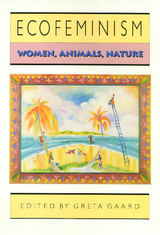 Ecofeminism
edited by Greta Gaard
Temple University Press, 1993 Drawing on the insights of ecology, feminism, and socialism, ecofeminism's basic premise is that the ideology that authorizes oppression based on race, class, gender, sexuality, physical abilities, and species is the same ideology that sanctions the oppression of nature. In this collection of essays, feminist scholars and activists discuss the relationships among human begins, the natural environment, and nonhuman animals. They reject the nature/culture dualism of patriarchal thought and locate animals and humans within nature. The goal of these twelve articles is to contribute to the evolving dialogue among feminists, ecofeminists, animal liberationists, deep ecologists, and social ecologists in an effort to create a sustainable lifestyle for all inhabitants of the earth. Among the issues addressed are the conflicts between Green politics and ecofeminism, various applications of ecofeminist theory, the relationship of animal liberation to ecofeminism, harmful implications of the romanticized woman-nature association in Western culture, and cultural limitations of ecofeminism. In the series Ethics and Action, edited by Tom Regan.
 Ecofeminist Literary Criticism: Theory, Interpretation, Pedagogy
Edited by Greta Gaard and Patrick D. Murphy
University of Illinois Press, 1998 Ecofeminist Literary Criticism is the first collection of its kind: a diverse anthology that explores both how ecofeminism can enrich literary criticism and how literary criticism can contribute to ecofeminist theory and activism. Ecofeminism is a practical movement for social change that discerns interconnections among all forms of oppression: the exploitation of nature, the oppression of women, class exploitation, racism, colonialism. Against binary divisions such as self/other, culture/nature, man/woman, humans/animals, and white/non-white, ecofeminist theory asserts that human identity is shaped by more fluid relationships and by an acknowledgment of both connection and difference. Once considered the province of philosophy and women's studies, ecofeminism in recent years has been incorporated into a broader spectrum of academic discourse. Ecofeminist Literary Criticism assembles some of the most insightful advocates of this perspective to illuminate ecofeminism as a valuable component of literary criticism.
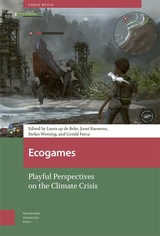 Ecogames: Playful Perspectives on the Climate Crisis
Laura op de Beke
Amsterdam University Press, 2024 With the climate crisis and its repercussions becoming more and more tangible, games are increasingly participating in the production, circulation, and interrogation of environmental assumptions, using both explicit and implicit ways of framing the crisis. Whether they are providing new spaces to imagine and practice alternative forms of living, or reproducing ecomodernist fantasies, games as well as player cultures are increasingly tuned in to the most pressing environmental concerns.
This book brings together chapters by a diverse group of established and emerging authors to develop a growing body of scholarship that explores the shape, impact, and cultural context of ecogames. The book comprises four thematic sections, Today’s Challenges: Games for Change, Future Worlds: New Imaginaries, The Nonhuman Turn, and Critical Metagaming Practices. Each section explores different aspects of ecocritical engagement in and through games. As a result, the book’s comprehensive scope covers a variety of angles, methodologies, and case studies, significantly expanding the field of green media studies.
 Ecohumanism and the Ecological Culture: The Educational Legacy of Lewis Mumford and Ian McHarg
William J. Cohen
Temple University Press, 2019 Lewis Mumford, one of the most respected public intellectuals of the twentieth century, speaking at a conference on the future environments of North America, said, “In order to secure human survival we must transition from a technological culture to an ecological culture.” In Ecohumanism and the Ecological Culture, William Cohen shows how Mumford’s conception of an educational philosophy was enacted by Mumford’s mentee, Ian McHarg, the renowned landscape architect and regional planner at the University of Pennsylvania. McHarg advanced a new way to achieve an ecological culture―through an educational curriculum based on fusing ecohumanism to the planning and design disciplines. Cohen explores Mumford’s important vision of ecohumanism—a synthesis of natural systems ecology with the myriad dimensions of human systems, or human ecology―and how McHarg actually formulated and made that vision happen. He considers the emergence of alternative energy systems and new approaches to planning and community development to achieve these goals. The ecohumanism graduate curriculum should become the basis to train the next generation of planners and designers to lead us into the ecological culture, thereby securing the educational legacy of both Lewis Mumford and Ian McHarg.
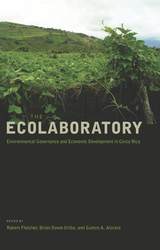 The Ecolaboratory: Environmental Governance and Economic Development in Costa Rica
Edited by Robert Fletcher, Brian Dowd-Uribe, and Guntra A. Aistara
University of Arizona Press, 2020 Despite its tiny size and seeming marginality to world affairs, the Central American republic of Costa Rica has long been considered an important site for experimentation in cutting-edge environmental policy. From protected area management to ecotourism to payment for environmental services (PES) and beyond, for the past half-century the country has successfully positioned itself at the forefront of novel trends in environmental governance and sustainable development. Yet the increasingly urgent dilemma of how to achieve equitable economic development in a world of ecosystem decline and climate change presents new challenges, testing Costa Rica’s ability to remain a leader in innovative environmental governance.
This book explores these challenges, how Costa Rica is responding to them, and the lessons this holds for current and future trends regarding environmental governance and sustainable development. It provides the first comprehensive assessment of successes and challenges as they play out in a variety of sectors, including agricultural development, biodiversity conservation, water management, resource extraction, and climate change policy.
By framing Costa Rica as an “ecolaboratory,” the contributors in this volume examine the lessons learned and offer a path for the future of sustainable development research and policy in Central America and beyond.
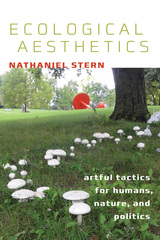 Ecological Aesthetics: artful tactics for humans, nature, and politics
Nathaniel Stern
Dartmouth College Press, 2018 With this poetic and scholarly collection of stories about art, artists, and their materials, Nathaniel Stern argues that ecology, aesthetics, and ethics are inherently entwined, and together act as the cornerstone for all contemporary arts practices. An ecological approach, says Stern, takes account of agents, processes, thoughts, and relations. Humans, matter, concepts, things, not-yet-things, politics, economics, and industry are all actively shaped in, and as, their interrelation. And aesthetics are a style of, and orientation toward, thought—and thus action. Including dozens of color images, this book narrativizes artists and artworks—ranging from print to installation, bio art to community activism—contextualizing and amplifying our experiences and practices of complex systems and forces, our experiences and practices of thought. Stern, an artist himself, writes with an eco-aesthetic that continually unfurls artful tactics that can also be used in everyday existence.
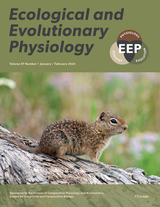 Ecological and Evolutionary Physiology, volume 97 number 1 (January/February 2024)
The University of Chicago Press
University of Chicago Press Journals, 2024 This is volume 97 issue 1 of Ecological and Evolutionary Physiology. Ecological and Evolutionary Physiology primarily publishes original research in physiological ecology, ecophysiology, comparative physiology, and evolutionary physiology. Studies at all levels of biological organization from the molecular to the whole organism are welcome, and work that integrates across levels of organization is particularly encouraged. Studies that focus on behavior or morphology are welcome, so long as they include ties to physiology or biochemistry, in addition to having an ecological or evolutionary context. Subdisciplines of interest include nutrition and digestion, salt and water balance, epithelial and membrane transport, gas exchange and transport, acid-base balance, temperature adaptation, energetics, structure and function of macromolecules, chemical coordination and signal transduction, nitrogen metabolism and excretion, locomotion and muscle function, biomechanics, circulation, behavioral, comparative and mechanistic endocrinology, sensory physiology, neural coordination, and ecotoxicology ecoimmunology.
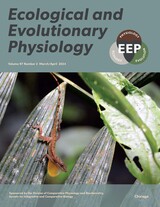 Ecological and Evolutionary Physiology, volume 97 number 2 (March/April 2024)
The University of Chicago Press
University of Chicago Press Journals, 2024 This is volume 97 issue 2 of Ecological and Evolutionary Physiology. Ecological and Evolutionary Physiology primarily publishes original research in physiological ecology, ecophysiology, comparative physiology, and evolutionary physiology. Studies at all levels of biological organization from the molecular to the whole organism are welcome, and work that integrates across levels of organization is particularly encouraged. Studies that focus on behavior or morphology are welcome, so long as they include ties to physiology or biochemistry, in addition to having an ecological or evolutionary context. Subdisciplines of interest include nutrition and digestion, salt and water balance, epithelial and membrane transport, gas exchange and transport, acid-base balance, temperature adaptation, energetics, structure and function of macromolecules, chemical coordination and signal transduction, nitrogen metabolism and excretion, locomotion and muscle function, biomechanics, circulation, behavioral, comparative and mechanistic endocrinology, sensory physiology, neural coordination, and ecotoxicology ecoimmunology.
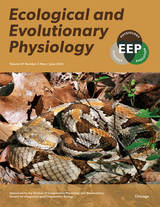 Ecological and Evolutionary Physiology, volume 97 number 3 (May/June 2024)
The University of Chicago Press
University of Chicago Press Journals, 2024 This is volume 97 issue 3 of Ecological and Evolutionary Physiology. Ecological and Evolutionary Physiology primarily publishes original research in physiological ecology, ecophysiology, comparative physiology, and evolutionary physiology. Studies at all levels of biological organization from the molecular to the whole organism are welcome, and work that integrates across levels of organization is particularly encouraged. Studies that focus on behavior or morphology are welcome, so long as they include ties to physiology or biochemistry, in addition to having an ecological or evolutionary context. Subdisciplines of interest include nutrition and digestion, salt and water balance, epithelial and membrane transport, gas exchange and transport, acid-base balance, temperature adaptation, energetics, structure and function of macromolecules, chemical coordination and signal transduction, nitrogen metabolism and excretion, locomotion and muscle function, biomechanics, circulation, behavioral, comparative and mechanistic endocrinology, sensory physiology, neural coordination, and ecotoxicology ecoimmunology.
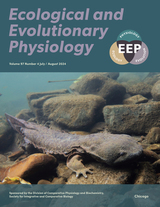 Ecological and Evolutionary Physiology, volume 97 number 4 (July/August 2024)
The University of Chicago Press
University of Chicago Press Journals, 2024 This is volume 97 issue 4 of Ecological and Evolutionary Physiology. Ecological and Evolutionary Physiology primarily publishes original research in physiological ecology, ecophysiology, comparative physiology, and evolutionary physiology. Studies at all levels of biological organization from the molecular to the whole organism are welcome, and work that integrates across levels of organization is particularly encouraged. Studies that focus on behavior or morphology are welcome, so long as they include ties to physiology or biochemistry, in addition to having an ecological or evolutionary context. Subdisciplines of interest include nutrition and digestion, salt and water balance, epithelial and membrane transport, gas exchange and transport, acid-base balance, temperature adaptation, energetics, structure and function of macromolecules, chemical coordination and signal transduction, nitrogen metabolism and excretion, locomotion and muscle function, biomechanics, circulation, behavioral, comparative and mechanistic endocrinology, sensory physiology, neural coordination, and ecotoxicology ecoimmunology.
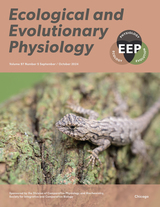 Ecological and Evolutionary Physiology, volume 97 number 5 (September/October 2024)
The University of Chicago Press
University of Chicago Press Journals, 2024 This is volume 97 issue 5 of Ecological and Evolutionary Physiology. Ecological and Evolutionary Physiology primarily publishes original research in physiological ecology, ecophysiology, comparative physiology, and evolutionary physiology. Studies at all levels of biological organization from the molecular to the whole organism are welcome, and work that integrates across levels of organization is particularly encouraged. Studies that focus on behavior or morphology are welcome, so long as they include ties to physiology or biochemistry, in addition to having an ecological or evolutionary context. Subdisciplines of interest include nutrition and digestion, salt and water balance, epithelial and membrane transport, gas exchange and transport, acid-base balance, temperature adaptation, energetics, structure and function of macromolecules, chemical coordination and signal transduction, nitrogen metabolism and excretion, locomotion and muscle function, biomechanics, circulation, behavioral, comparative and mechanistic endocrinology, sensory physiology, neural coordination, and ecotoxicology ecoimmunology.
 Ecological and Evolutionary Physiology, volume 97 number 6 (November/December 2024)
The University of Chicago Press
University of Chicago Press Journals, 2024 This is volume 97 issue 6 of Ecological and Evolutionary Physiology. Ecological and Evolutionary Physiology primarily publishes original research in physiological ecology, ecophysiology, comparative physiology, and evolutionary physiology. Studies at all levels of biological organization from the molecular to the whole organism are welcome, and work that integrates across levels of organization is particularly encouraged. Studies that focus on behavior or morphology are welcome, so long as they include ties to physiology or biochemistry, in addition to having an ecological or evolutionary context. Subdisciplines of interest include nutrition and digestion, salt and water balance, epithelial and membrane transport, gas exchange and transport, acid-base balance, temperature adaptation, energetics, structure and function of macromolecules, chemical coordination and signal transduction, nitrogen metabolism and excretion, locomotion and muscle function, biomechanics, circulation, behavioral, comparative and mechanistic endocrinology, sensory physiology, neural coordination, and ecotoxicology ecoimmunology.
 Ecological and Evolutionary Physiology, volume 98 number 1 (January/February 2025)
The University of Chicago Press
University of Chicago Press Journals, 2025 This is volume 98 issue 1 of Ecological and Evolutionary Physiology. Ecological and Evolutionary Physiology primarily publishes original research in physiological ecology, ecophysiology, comparative physiology, and evolutionary physiology. Studies at all levels of biological organization from the molecular to the whole organism are welcome, and work that integrates across levels of organization is particularly encouraged. Studies that focus on behavior or morphology are welcome, so long as they include ties to physiology or biochemistry, in addition to having an ecological or evolutionary context. Subdisciplines of interest include nutrition and digestion, salt and water balance, epithelial and membrane transport, gas exchange and transport, acid-base balance, temperature adaptation, energetics, structure and function of macromolecules, chemical coordination and signal transduction, nitrogen metabolism and excretion, locomotion and muscle function, biomechanics, circulation, behavioral, comparative and mechanistic endocrinology, sensory physiology, neural coordination, and ecotoxicology ecoimmunology.
 Ecological and Evolutionary Physiology, volume 98 number 2 (March/April 2025)
The University of Chicago Press
University of Chicago Press Journals, 2025 This is volume 98 issue 2 of Ecological and Evolutionary Physiology. Ecological and Evolutionary Physiology primarily publishes original research in physiological ecology, ecophysiology, comparative physiology, and evolutionary physiology. Studies at all levels of biological organization from the molecular to the whole organism are welcome, and work that integrates across levels of organization is particularly encouraged. Studies that focus on behavior or morphology are welcome, so long as they include ties to physiology or biochemistry, in addition to having an ecological or evolutionary context. Subdisciplines of interest include nutrition and digestion, salt and water balance, epithelial and membrane transport, gas exchange and transport, acid-base balance, temperature adaptation, energetics, structure and function of macromolecules, chemical coordination and signal transduction, nitrogen metabolism and excretion, locomotion and muscle function, biomechanics, circulation, behavioral, comparative and mechanistic endocrinology, sensory physiology, neural coordination, and ecotoxicology ecoimmunology.
 Ecological and Evolutionary Physiology, volume 98 number 3 (May/June 2025)
The University of Chicago Press
University of Chicago Press Journals, 2025 This is volume 98 issue 3 of Ecological and Evolutionary Physiology. Ecological and Evolutionary Physiology primarily publishes original research in physiological ecology, ecophysiology, comparative physiology, and evolutionary physiology. Studies at all levels of biological organization from the molecular to the whole organism are welcome, and work that integrates across levels of organization is particularly encouraged. Studies that focus on behavior or morphology are welcome, so long as they include ties to physiology or biochemistry, in addition to having an ecological or evolutionary context. Subdisciplines of interest include nutrition and digestion, salt and water balance, epithelial and membrane transport, gas exchange and transport, acid-base balance, temperature adaptation, energetics, structure and function of macromolecules, chemical coordination and signal transduction, nitrogen metabolism and excretion, locomotion and muscle function, biomechanics, circulation, behavioral, comparative and mechanistic endocrinology, sensory physiology, neural coordination, and ecotoxicology ecoimmunology.
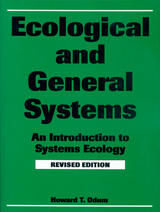 Ecological and General Systems: An Introduction to Systems Ecology, Revised Edition
Howard T. Odum
University Press of Colorado, 1994 Using an energy systems language that combines energetics, kinetics, information, cybernetics, and simulation, Ecological and General Systems compares models of many fields of science, helping to derive general systems principles. First published as Systems Ecology in 1983, Ecological and General Systems proposes principles of self-organization and the designs that prevail by maximizing power and efficiency. Comparisons to fifty other systems languages are provided. Innovative presentations are given on earth homeostasis (Gaia); the inadequacy of presenting equations without network relationships and energy constraints; the alternative interpretation of high entropy complexity as adaptive structure; basic equations of ecological economics; and the energy basis of scientific hierarchy. Part I introduces energetics, hierarchy, and systems modeling. Part II features design elements: intersections, autocatalytic modules, loops, series, parallel elements, and webs. Part III includes embodied energy, spectra of energy quality, temperature, complexity, spatial distribution, and diversity. Part IV discusses production, consumption, ecosystems, succession, economic systems, anthropological models, urban and regional models, global biogeochemistry, and the universe.
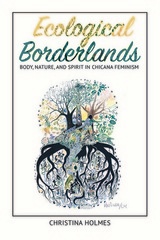 Ecological Borderlands: Body, Nature, and Spirit in Chicana Feminism
Christina Holmes
University of Illinois Press, 2016 Environmental practices among Mexican American woman have spurred a reconsideration of ecofeminism among Chicana feminists. Christina Holmes examines ecological themes across the arts, Chicana activism, and direct action groups to reveal how Chicanas can craft alternative models for ecofeminist processes.
Holmes revisits key debates to analyze issues surrounding embodiment, women's connections to nature, and spirituality's role in ecofeminist philosophy and practice. By doing so, she challenges Chicanas to escape the narrow frameworks of the past in favor of an inclusive model of environmental feminism that alleviates Western biases. Holmes uses readings of theory, elaborations of ecological narratives in Chicana cultural productions, histories of human and environmental rights struggles in the Southwest, and a description of an activist exemplar to underscore the importance of living with decolonializing feminist commitment in body, nature, and spirit.
The Ecological City: Preserving and Restoring Urban Biodiversity
Rutherford H. Platt
University of Massachusetts Press, 1994 Interdisciplinary in content as well as approach, this collection of original essays takes a fresh look at the ecology of urban communities. Written by experts from a variety of professions--academic researchers, private and public program managers, and citizen activists--the book explores issues of geography, ecology, landscape architecture, urban forestry, law, and environmental education. Contributions include broad overviews of common problems a well as detailed case studies of specific programs.
Although several contributors are natural scientists, the book focuses on matters of public policy and public-private collaboration. The aim is not only to assess the impact of increasing urbanization on biodiversity, but also to propose new ways of preserving and restoring the balance between the natural and the built environment through planning and design.
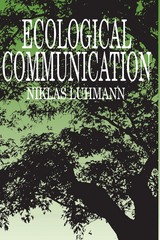 Ecological Communication
Niklas Luhmann
University of Chicago Press, 1989 Niklas Luhmann is widely recognized as one of the most original thinkers in the social sciences today. This major new work further develops the theories of the author by offering a challenging analysis of the relationship between society and the environment.
Luhmann extends the concept of "ecology" to refer to any analysis that looks at connections between social systems and the surrounding environment. He traces the development of the notion of "environment" from the medieval idea—which encompasses both human and natural systems—to our modern definition, which separates social systems from the external environment.
In Luhmann's thought, human beings form part of the environment, while social systems consist only of communications. Utilizing this distinctive theoretical perspective, Luhmann presents a comprehensive catalog of society's reactions to environmental problems. He investigates the spheres of the economy, law, science, politics, religion, and education to show how these areas relate to environmental issues.
Ecological Communication is an important work that critically examines claims central to our society—claims to modernity and rationality. It will be of great importance to scholars and students in sociology, political science, philosophy, anthropology, and law.
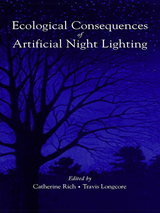 Ecological Consequences of Artificial Night Lighting
Edited by Catherine Rich and Travis Longcore
Island Press, 2006 While certain ecological problems associated with artificial night lighting are widely known-for instance, the disorientation of sea turtle hatchlings by beachfront lighting-the vast range of influences on all types of animals and plants is only beginning to be recognized. From nest choice and breeding success of birds to behavioral and physiological changes in salamanders, many organisms are seriously affected by human alterations in natural patterns of light and dark. Ecological Consequences of Artificial Night Lighting is the first book to consider the environmental effects of the intentional illumination of the night. It brings together leading scientists from around the world to review the state of knowledge on the subject and to describe specific effects that have been observed across a full range of taxonomic groups, including mammals, birds, reptiles and amphibians, fishes, invertebrates, and plants. Ecological Consequences of Artificial Night Lighting provides a scientific basis to begin addressing the challenge of conserving the nighttime environment. It cogently demonstrates the vital importance of this until-now neglected topic and is an essential new work for conservation planners, researchers, and anyone concerned with human impacts on the natural world.
Ecological Debt: Global Warming and the Wealth of Nations
Andrew Simms
Pluto Press, 2009 This is the second edition of Andrew Simms's highly regarded guide to ecological debt.
Simms shows how millions of us in the West are running up huge ecological debts: from the amount of oil and coal that we burn to heat our houses and run our cars, to what we consume and the waste that we create, the impact of our lifestyles is felt worldwide. Whilst these debts go unpaid, millions more living in poverty in the majority world suffer the burden of paying dubious foreign financial debts.
The book explores a great paradox of our age: how the global wealth gap was built on ecological debts, which the world's poorest are now having to pay for. Highlighting how and why this has happened, he also shows what can be done differently in the future. Now updated throughout, this is a clear and passionate account of the steps we can take to stop pushing the planet to the point of environmental bankruptcy.
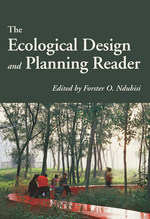 The Ecological Design and Planning Reader
Forster O. Ndubisi
Island Press, 2014 From Henry David Thoreau to Rachel Carson, writers have long examined the effects of industrialization and its potential to permanently alter the world around them. Today, as we experience rapid global urbanization, pressures on the natural environment to accommodate our daily needs for food, work, shelter, and recreation are greatly intensified. Concerted efforts to balance human use with ecological concerns are needed now more than ever.
A rich body of literature on the effect of human actions on the natural environment provides a window into what we now refer to as ecological design and planning. The study and practice of ecological design and planning provide a promising way to manage change in the landscape so that human actions are more in tune with natural processes. In The Ecological Design and Planning Reader Professor Ndubisi offers refreshing insights into key themes that shape the theory and practice of ecological design and planning. He has assembled, synthesized, and framed selected seminal published scholarly works in the field from the past one hundred and fifty years——ranging from Ebenezer Howard’s Garden Cities of To-morrow to Anne Whiston Spirn’s, “Ecological Urbanism: A Framework for the Design of Resilient Cities.” The reader ends with a hopeful look forward, which suggests an agenda for future research and analysis in ecological design and planning.
This is the first volume to bring together classic and contemporary writings on the history, evolution, theory, methods, and exemplary practice of ecological design and planning. The collection provides students, scholars, researchers, and practitioners with a solid foundation for understanding the relationship between human systems and our natural environment.
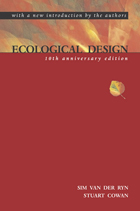 Ecological Design, Tenth Anniversary Edition
Sim Van der Ryn and Stuart Cowan
Island Press, 2007 Ecological Design is a landmark volume that helped usher in an exciting new era in green design and sustainability planning. Since its initial publication in 1996, the book has been critically important in sparking dialogue and triggering collaboration across spatial scales and design professions in pursuit of buildings, products, and landscapes with radically decreased environmental impacts. This 10th anniversary edition makes the work available to a new generation of practitioners and thinkers concerned with moving our society onto a more sustainable path. Using examples from architecture, industrial ecology, sustainable agriculture, ecological wastewater treatment, and many other fields, Ecological Design provides a framework for integrating human design with living systems. Drawing on complex systems, ecology, and early examples of green building and design, the book challenges us to go further, creating buildings, infrastructures, and landscapes that are truly restorative rather than merely diminishing the rate at which things are getting worse.
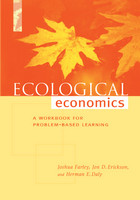 Ecological Economics: A Workbook for Problem-Based Learning
Joshua Farley, Jon D. Erickson, and Herman E. Daly
Island Press, 2005 Ecological economics addresses one of the fundamental flaws in conventional economics--its failure to consider biophysical and social reality in its analyses and equations. Ecological Economics: Principles and Applications is an introductory-level textbook that offers a pedagogically complete examination of this dynamic new field. As a workbook accompanying the text, this volume breaks new ground in applying the principles of ecological economics in a problem- or service-based learning setting. Both the textbook and this workbook are situated within a new interdisciplinary framework that embraces the linkages among economic growth, environmental degradation, and social inequity in an effort to guide policy in a way that respects fundamental human values. The workbook takes the approach a step further in placing ecological economic analysis within a systems perspective, in order to help students identify leverage points by which they can help to affect change. The workbook helps students to develop a practical, operational understanding of the principles and concepts explored in the text through real-world activities, and describes numerous case studies in which students have successfully completed projects. Ecological Economics: A Workbook for Problem-Based Learning represents an important new resource for undergraduate and graduate environmental studies courses focusing on economics, environmental policy, and environmental problem-solving.
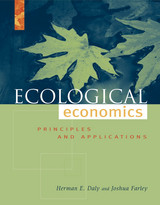 Ecological Economics: Principles And Applications
Herman E. Daly and Joshua Farley
Island Press, 2003 Conventional economics is often criticized for failing to reflect adequately the value of clean air and water, species diversity, and social and generational equity. By excluding biophysical and social systems from their analyses, many conventional economists overlook problems of the increasing scale of human impacts and the inequitable distribution of resources.
Ecological Economics is an introductory-level textbook for an emerging paradigm that addresses this flaw in much economic thought. The book defines a revolutionary "transdiscipline" that incorporates insights from the biological, physical, and social sciences, and it offers a pedagogically complete examination of this exciting new field. It provides students with a foundation in traditional neoclassical economic thought, but places that foundation within a new interdisciplinary framework that embraces the linkages among economic growth, environmental degradation, and social inequity.
Introducing the three core issues that are the focus of the new transdiscipline -- scale, distribution, and efficiency -- the book is guided by the fundamental question, often assumed but rarely spoken in traditional texts: What is really important to us? After explaining the key roles played by the earth's biotic and abiotic resources in sustaining life, the text is then organized around the main fields in traditional economics: microeconomics, macroeconomics, and international economics. The book also takes an additional step of considering the policy implications of this line of thinking.
Ecological Economics includes numerous features that make it accessible to a wide range of students:
more than thirty text boxes that highlight issues of special importance to students
lists of key terms that help students organize the main points in each chapter
concise definitions of new terms that are highlighted in the text for easy reference
study questions that encourage student exploration beyond the text
glossary and list of further readings
An accompanying workbook presents an innovative, applied problem-based learning approach to teaching economics.
While many books have been written on ecological economics, and several textbooks describe basic concepts of the field, this is the only stand-alone textbook that offers a complete explanation of both theory and practice. It will serve an important role in educating a new generation of economists and is an invaluable new text for undergraduate and graduate courses in ecological economics, environmental economics, development economics, human ecology, environmental studies, sustainability science, and community development.
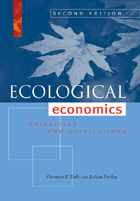 Ecological Economics, Second Edition: Principles and Applications
Herman E. Daly and Joshua Farley
Island Press, 2009 In its first edition, this book helped to define the emerging field of ecological economics. This new edition surveys the field today. It incorporates all of the latest research findings and grounds economic inquiry in a more robust understanding of human needs and behavior. Humans and ecological systems, it argues, are inextricably bound together in complex and long-misunderstood ways. According to ecological economists, conventional economics does not reflect adequately the value of essential factors like clean air and water, species diversity, and social and generational equity. By excluding biophysical and social systems from their analyses, many conventional economists have overlooked problems of the increasing scale of human impacts and the inequitable distribution of resources. This introductory-level textbook is designed specifically to address this significant flaw in economic thought. The book describes a relatively new “transdiscipline” that incorporates insights from the biological, physical, and social sciences. It provides students with a foundation in traditional neoclassical economic thought, but places that foundation within an interdisciplinary framework that embraces the linkages among economic growth, environmental degradation, and social inequity. In doing so, it presents a revolutionary way of viewing the world. The second edition of Ecological Economics provides a clear, readable, and easy-to-understand overview of a field of study that continues to grow in importance. It remains the only stand-alone textbook that offers a complete explanation of theory and practice in the discipline.
 Ecological Ethics and the Human Soul: Aquinas, Whitehead, and the Metaphysics of Value
Francisco J. Benzoni
University of Notre Dame Press, 2008
In Ecological Ethics and the Human Soul: Aquinas, Whitehead, and the Metaphysics of Value, Francisco J. Benzoni addresses the pervasive and destructive view that there is a moral gulf between human beings and other creatures. Thomas Aquinas, whose metaphysics entails such a moral gulf, holds that human beings are ultimately separate from nature. Alfred North Whitehead, in contrast, maintains that human beings are continuous with the rest of nature. These different metaphysical systems demand different ethical stances toward creation.
Benzoni analyzes and challenges Thomas's understanding of the human soul, his primary justification for the moral separation, arguing that it is finally philosophically untenable. The author finds promising the alternative metaphysics of Whitehead, for whom human beings are a part of nature—even if the highest part; all creatures have a degree of subjectivity and creativity, and thus all have intrinsic value and moral worth, independent of subjective human valuation. Further, though there is difference, there is no moral gulf between God and the world. God is truly affected by the experience of creatures. Benzoni argues that if this vision of moral worth is articulated with sufficient force and clarity, it could help heal the human relation to our planet.
“Eminently clear in concept and analysis, profound in insight, and precise in reasoning, this book not only contributes a distinguished study of Aquinas but also reshapes contemporary ecological ethics by relating it to basic issues of metaphysics. Both subsequent moral theory attentive to Aquinas and subsequent formulations of ecological ethics will be incomplete without taking account of Benzoni's argument.” —Franklin I. Gamwell, Shailer Mathews Distinguished Service Professor of Religious Ethics, the Philosophy of Religion, and Theology, The University of Chicago Divinity School
“In the introduction and conclusion, Francisco Benzoni makes clear the broader significance of this work for the field of ecological ethics and the future well-being of the human species on this earth. One can learn a great deal about the philosophy of both Aquinas and Whitehead in working through these pages.” —Joseph Bracken, Xavier University
 Ecological Explosions: The History of Biological Invasions and Invasion Science
Daniel Simberloff
University of Chicago Press A leading biologist offers a comprehensive and accessible history of invasive species science, from its earliest antecedents through its current research foci and controversies.
From the arrival of the naval shipworm in the Black Sea in the first millennium BC to the escape of the Burmese python in Florida in 1992, humans have moved species to new locations, deliberately or inadvertently, for thousands of years. Agricultural and environmental impacts of some invasions were evident early, although whether observers recognized that the cause was an introduced species is uncertain. The history of invasion biology truly begins in the sixteenth through eighteenth centuries, when explorers noticed European species on various distant islands and in North America. In the nineteenth century, biogeographers, studying species distributions across the globe, introduced the first native and non-native species categorizations, and prominent researchers like Charles Darwin began to describe the impacts of introduced species. In the nineteenth and twentieth centuries, as humans moved increasing numbers of species across the globe, the advent of modern ecology deepened our understanding of the scope of the problem.
In Ecological Explosions, invasive species expert Daniel Simberloff provides a thorough overview of the development of invasion science, from early research—including from the perspectives of leading scientists like Aldo Leopold—to the field’s future. Simberloff explores the work of pioneering ecologists like Charles Elton, antecedents of what became today’s invasion biology, before discussing the field’s true emergence in the 1980s, its explosive methodological and theoretical expansion, its integration with other disciplines, and its increasing visibility, not only within the biological literature but also in government policies across the world in the 1990s. Finally, he investigates current controversies, such as the debate over whether the entire science is xenophobic, and asks how ecosystems might adapt to a rapidly globalizing world and ever-increasing numbers of introduced species—including the joro spider, lionfish, spotted lanternfly, common reed, and Asian carp.
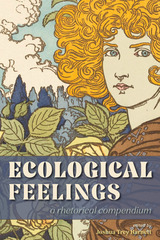 Ecological Feelings: A Rhetorical Compendium
Joshua Trey Barnett
Michigan State University Press, 2025 These days, earthly coexistence often feels bad. As environmental crises amass, they cast a shadow over an imagined future and the promises of better—or at least predictable—days to come. In times of climate chaos, mass extinction, and rampant environmental injustice, it is easy to despair. But, here and there, a glimmer of joy or optimism shines forth and reminds us that it is possible—even necessary—to love and to hope amid the ruins. The contributors to this volume grapple with a plurality of interrelated ecological feelings: care, concern, contempt, empathy, fear, grief, hope, joy, numbness, optimism, possessiveness, regret, and saudades. Informed by a rhetorical perspective, the essays collected here reveal what sets our ecological feelings into motion. Crucially, they also uncover some of the rhetorical practices through which we might collectively feel our way into a more harmonious earthly coexistence.
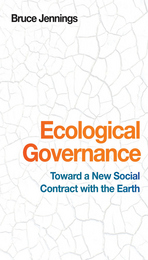 Ecological Governance: Toward a New Social Contract with the Earth
Bruce Jennings
West Virginia University Press, 2016 As our economic and natural systems continue on their collision course, Bruce Jennings asks whether we have the political capacity to avoid large-scale environmental disaster. Can liberal democracy, he wonders, respond in time to ecological challenges that require dramatic changes in the way we approach the natural world? Must a more effective governance be less democratic and more autocratic? Or can a new form of grassroots ecological democracy save us from ourselves and the false promises of material consumption run amok? Ecological Governance is an ethicist’s reckoning with how our political culture, broadly construed, must change in response to climate change. Jennings argues that during the Anthropocene era a social contract of consumption has been forged. Under it people have given political and economic control to elites in exchange for the promise of economic growth. In a new political economy of the future, the terms of the consumptive contract cannot be met without severe ecological damage. We will need a new guiding vision and collective aim, a new social contract of ecological trusteeship and responsibility.
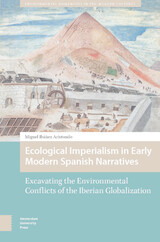 Ecological Imperialism in Early Modern Spanish Narratives: Excavating the Environmental Conflicts of the Iberian Globalization
Miguel Ibáñez Aristondo
Amsterdam University Press, 2025 How are the environmental conflicts of our time intertwined with the legacies of Spanish imperialism and early modern globalization? In Ecological Imperialism in Early Modern Spanish Narratives: Excavating the Environmental Conflicts of the Iberian Globalization, Miguel Ibáñez Aristondo argues that to understand the historical ramifications of the ecological crisis, it is imperative to excavate the fragmented histories and entangled viewpoints associated with European imperialism. Drawing on early modern Iberian, Indigenous, and European sources, the book interrogates how early modern debates regarding war, free trade, abundance, property, race, sovereignty, and history were deeply entwined within ideas and theories driving the relationship between humans and the environment. By exploring the conflict-ridden experiences arising from Spanish imperialism, the book argues that ecological crises have given rise to divergent visions and social hierarchies over time, driven by environmental conflicts opposing social justice and collective life to capital accumulation and imperial competition.
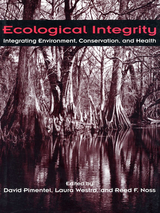 Ecological Integrity: Integrating Environment, Conservation, and Health
Edited by David Pimentel, Laura Westra, and Reed F. Noss
Island Press, 2000 Global Integrity Project has brought together leading scientists and thinkers from around the world to examine the combined problems of threatened and unequal human well-being, degradation of the ecosphere, and unsustainable economies. Based on the proposition that healthy, functioning ecosystems are a necessary prerequisite for both economic security and social justice, the project is built around the concept of ecological integrity and its practical implications for policy and management. Ecological Integrity presents a synthesis and findings of the project. Contributors -- including Robert Goodland, James Karr, Orie Loucks, Jack Manno, William Rees, Mark Sagoff, Robert Ulanowicz, Philippe Crabbe, Laura Westra, David Pimentel, Reed Noss, and others -- examine the key elements of ecological integrity and consider what happens when integrity is lost or compromised. The book: - examines historical and philosophical foundations of the concept of ecological integrity
- explores how integrity can be measured
- examines the relationships among ecological integrity, human health, and food production
- looks at economic and ethical issues that need to be considered in protecting ecological integrity
- offers concrete recommendations for reversing ecological degradation while promoting social and economic justice and welfare
. Contributors argue that there is an urgent need for rapid and fundamental change in the ecologically destructive patterns of collective human behavior if society is to survive and thrive in coming decades. Ecological Integrity is a groundbreaking book that integrates environmental science, economics, law, and ethics in problem analysis, synthesis, and solution, and is a vital contribution for anyone concerned with interactions between human and planetary health.
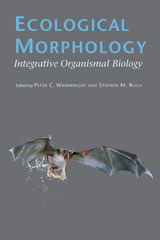 Ecological Morphology: Integrative Organismal Biology
Edited by Peter C. Wainwright and Stephen M. Reilly
University of Chicago Press, 1994 Ecological morphology examines the relation between an animal's anatomy and physiology—its form and function—and how the animal has evolved in and can inhabit a particular environment. Within the past few years, research in this relatively new area has exploded. Ecological Morphology is a synthesis of major concepts and a demonstration of the ways in which this integrative approach can yield rich and surprising results.
Through this interdisciplinary study, scientists have been able to understand, for instance, how bat wing design affects habitat use and bat diet; how the size of a predator affects its ability to capture and eat certain prey; and how certain mosquitoes have evolved physiologically and morphologically to tolerate salt-water habitats. Ecological Morphology also covers the history of the field, the role of the comparative method in studying adaptation, and the use of data from modern organisms for understanding the ecology of fossil communities.
This book provides an overview of the achievements and potential of ecological morphology for all biologists and students interested in the way animal design, ecology, and evolution interact.
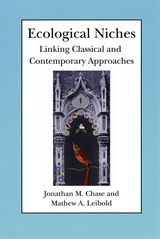 Ecological Niches: Linking Classical and Contemporary Approaches
Jonathan M. Chase and Mathew A. Leibold
University of Chicago Press, 2003 Why do species live where they live? What determines the abundance and diversity of species in a given area? What role do species play in the functioning of entire ecosystems? All of these questions share a single core concept—the ecological niche. Although the niche concept has fallen into disfavor among ecologists in recent years, Jonathan M. Chase and Mathew A. Leibold argue that the niche is an ideal tool with which to unify disparate research and theoretical approaches in contemporary ecology.
Chase and Leibold define the niche as including both what an organism needs from its environment and how that organism's activities shape its environment. Drawing on the theory of consumer-resource interactions, as well as its graphical analysis, they develop a framework for understanding niches that is flexible enough to include a variety of small- and large-scale processes, from resource competition, predation, and stress to community structure, biodiversity, and ecosystem function. Chase and Leibold's synthetic approach will interest ecologists from a wide range of subdisciplines.
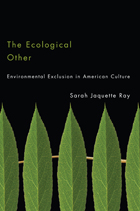 The Ecological Other: Environmental Exclusion in American Culture
Sarah Jaquette Ray
University of Arizona Press, 2013 With roots in eugenics and other social-control programs, modern American environmentalism is not always as progressive as we would like to think. In The Ecological Other, Sarah Jaquette Ray examines the ways in which environmentalism can create social injustice through discourses of the body.
Ray investigates three categories of ecological otherness: people with disabilities, immigrants, and Native Americans. Extending recent work in environmental justice ecocriticism, Ray argues that the expression of environmental disgust toward certain kinds of bodies draws problematic lines between ecological “subjects”—those who are good for and belong in nature—and ecological “others”—those who are threats to or out of place in nature. Ultimately, The Ecological Other urges us to be more critical of how we use nature as a tool of social control and to be careful about the ways in which we construct our arguments to ensure its protection.
The book challenges long-standing assumptions in environmentalism and will be of interest to those in environmental literature and history, American studies, disability studies, and Native American studies, as well as anyone concerned with issues of environmental justice.
 Ecological Poetics; or, Wallace Stevens’s Birds
Cary Wolfe
University of Chicago Press, 2020 The poems of Wallace Stevens teem with birds: grackles, warblers, doves, swans, nightingales, owls, peacocks, and one famous blackbird who summons thirteen ways of looking. What do Stevens’s evocations of birds, and his poems more generally, tell us about the relationship between human and nonhuman? In this book, the noted theorist of posthumanism Cary Wolfe argues for a philosophical and theoretical reinvention of ecological poetics, using Stevens as a test case.
Stevens, Wolfe argues, is an ecological poet in the sense that his places, worlds, and environments are co-created by the life forms that inhabit them. Wolfe argues for a “nonrepresentational” conception of ecopoetics, showing how Stevens’s poems reward study alongside theories of system, environment, and observation derived from a multitude of sources, from Ralph Waldo Emerson and Niklas Luhmann to Jacques Derrida and Stuart Kauffman. Ecological Poetics is an ambitious interdisciplinary undertaking involving literary criticism, contemporary philosophy, and theoretical biology.
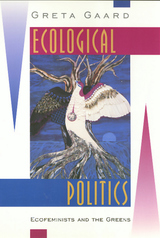 Ecological Politics
Greta Gaard
Temple University Press, 1998 In the 1980s, ecofeminism and the U.S. Green movement seemed to offer some of this country's most powerful and promising solutions to problems of social and environmental justice. A decade later, ecofeminism has become more a perspective than a movement, and divisions within the Greens have deepened as its national focus has shifted from issue-based politics to party building. Why have these movements faltered?
A member of both movements, Greta Gaard bases her analysis on her personal experience as well as extensive secondary sources and interviews with key theorists, activists, and speakers across the United States. By allowing each movement's members to speak for themselves, she traces the separate origins and development of each movement, explains their connections, and reveals the light that each can cast upon the other and on the difficulties facing social action in general.
Beginning with the ecofeminists, Gaard describes the paths -- environmental causes, the feminist peace movement, the feminist spirituality movement, the animal liberation movement, and the anti-toxics movements, as well as experiences of interconnectedness -- that have led women (and a few men) to articulate an ecofeminist perspective. Tracing the movement from the 1980s to the present, she defines its present strands as liberal ecofeminism, radical ecofeminism, socialist ecofeminism, and social ecofeminism.
Gaard illustrates the development of the U.S. Greens from a national movement into a political party. She defines the various factions -- the Left Greens, the Youth Greens, and the Green Politics Network -- that influenced the movement's direction and underlay the debates during Ralph Nadar's 1996 presidential campaign. She shows how the history of these three groups can be seen as stages in the transition from a leftist and sometimes anarchist action that places the Green movement squarely within the pattern of other social movements around the world.
Despite the significant influence that ecofeminists have had in shaping the Greens as a national movement, many have chosen to withdraw from the Greens. Gaard looks at the reasons for member disaffection and draws disturbing conclusions about the compatibility between liberal feminism and cultural ecofeminism and patriarchal politics. She also presents the divisions within the Greens as ongoing battles within the new left, the radical ecology movement, and various social justice movements. She focuses on three general areas -- conflicts over philosophy, conflicts over representation, and conflicts over strategy -- to make suggestions for how to bring about the kind of social transformation envisioned by both the Greens and the ecofeminists. Arguing that the Concord Principles represent a populist form of liberal democracy that fundamentally betrays both ecofeminism and Green philosophy, she uses the 1996 Nadar campaign as a departure point to developing an ecofeminist theory of radical democracy and to speculate on future directions for Green politics and for ecofeminism. Her analysis illuminates the nature and direction of each of these important movements and the pressures and conflicts experienced by all social movements at the end of the twentieth century.
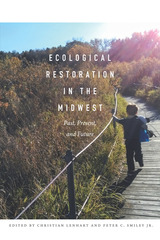 Ecological Restoration in the Midwest: Past, Present, and Future
Christian Lenhard and Peter C. Smiley, Jr.
University of Iowa Press, 2018 Most people do not realize it, but the Midwest has been at the forefront of ecological restoration longer than perhaps any other region in the United States, dating back to the 1930s. Because of its industrial history, agricultural productivity, and natural features such as the Great Lakes, the Midwest has always faced a unique set of ecological challenges. Focusing on six cutting-edge case studies that highlight thirty restoration efforts and research sites throughout the region— Iowa, Indiana, Illinois, Wisconsin, Michigan, Minnesota, and Ohio— editors Christian Lenhart and Peter “Rocky” Smiley Jr. bring together a group of scholars and practitioners to show how midwestern restoration efforts have developed, as well as where they are headed. Whether cleaning up contamination from auto plants in Ohio, or restoring native prairie grasses along the Iowa highway, the contributors uncover a vast network of interested citizens and volunteer groups committed to preserving the region’s environment. This study, intended for researchers, students, and practitioners, also provides an updated synthesis of restoration theory and practice, and pinpoints emerging issues of importance in the Midwest, such as climate change and the increase in invasive species it will bring to the region. Though focusing exclusively on the Midwest, the contributors demonstrate how these case studies apply to restoration efforts across the globe. Contributors: Luther Aadland, David P. Benson, Andrew F. Casper, Hua Chen, Joe DiMisa, Steve Glass, Heath M. Hagy, John A. Harrington, Neil Haugerud, Constance Hausman, Michael J. Lemke, Christian Lenhart, Jen Lyndall, Dan Shaw, John A. Shuey, Peter C. Smiley Jr., Daryl Smith
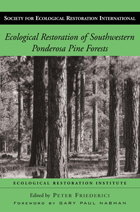 Ecological Restoration of Southwestern Ponderosa Pine Forests
Edited by Peter Friederici; Foreword by Gary Paul Nabhan ; Ecological Restoration Institute; Society for Ecological Restoration International
Island Press, 2003 Ecological Restoration of Southwestern Ponderosa Pine Forests brings together practitioners and thinkers from a variety of fields—including forestry, biology, philosophy, ecology, political science, archaeology, botany, and geography—to synthesize what is known about ecological restoration in ponderosa pine forests and to consider the factors involved in developing and implementing a successful restoration effort. The book examines:
• the overall context for restoration—ecological, social, economic, political, and philosophical
• how ecosystem processes such as fire, hydrology, and nutrient cycling are affected by restoration activities
• treatment effects on specific ecosystem components such as trees, understory plants, animals, and rare or invasive species
• the details of implementing restoration projects, including smoke management, the protection of cultural resources, and monitoring Each section is introduced with a case study that demonstrates some of the promise and pitfalls of restoration projects. Ecological Restoration of Southwestern Ponderosa Pine Forests is the second book in the series The Science and Practice of Ecological Restoration from the Society for Ecological Restoration International and Island Press.
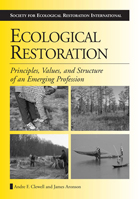 Ecological Restoration: Principles, Values, and Structure of an Emerging Profession
Andre F. Clewell and James Aronson
Island Press, 2008 The field of ecological restoration is a rapidly growing discipline that encompasses a wide range of activities and brings together practitioners and theoreticians from a variety of backgrounds and perspectives, ranging from volunteer backyard restorationists to highly trained academic scientists and professional consultants.
Ecological Restoration offers for the first time a unified vision of ecological restoration as a field of study, one that clearly states the discipline’s precepts and emphasizes issues of importance to those involved at all levels. In a lively, personal fashion, the authors discuss scientific and practical aspects of the field as well as the human needs and values that motivate practitioners. The book:
-identifies fundamental concepts upon which restoration is based
-considers the principles of restoration practice
-explores the diverse values that are fulfilled with the restoration of ecosystems
-reviews the structure of restoration practice, including the various contexts for restoration work, the professional development of its practitioners, and the relationships of restoration with allied fields and activities
A unique feature of the book is the inclusion of eight “virtual field trips,” short photo essays of project sites around the world that illustrate various points made in the book and are “led” by those who were intimately involved with the project described.
Throughout, ecological restoration is conceived as a holistic endeavor, one that addresses issues of ecological degradation, biodiversity loss, and sustainability science simultaneously, and draws upon cultural resources and local skills and knowledge in restoration work.
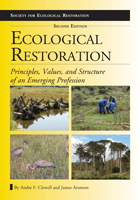 Ecological Restoration, Second Edition: Principles, Values, and Structure of an Emerging Profession
Andre F. Clewell and James Aronson
Island Press, 2013 Ecological restoration is no longer a niche practice—it’s a global, interdisciplinary movement uniting scientists, land stewards, policymakers, and community volunteers around the urgent task of repairing damaged ecosystems. This updated and reorganized edition offers a clear, engaging, and comprehensive guide to the field for anyone involved in restoration projects—from permitting and funding to design, implementation, and long-term care.
Blending scientific insight with real-world application, the authors introduce foundational concepts and principles while exploring the cultural, ecological, and personal motivations that drive restoration work. Through a lively and accessible style, they examine how restoration functions at the intersection of biodiversity conservation, sustainability, and community action.
This second edition of Ecological Restoration the structure of restoration practice, considers its evolving relationship with allied fields such as conservation biology and environmental planning, and reflects on the growth of the profession itself. It also features in-depth case studies and Virtual Field Trips from around the world, offering readers a window into diverse projects and the voices behind them.
More than a technical manual, this is a guide to thinking—and working—restoratively. It encourages readers to view restoration as a dynamic, holistic process rooted in local knowledge, ecological science, and a deep commitment to repairing our relationship with the natural world.
 The Ecological Thought
Timothy Morton
Harvard University Press, 2010 In this passionate, lucid, and surprising book, Timothy Morton argues that all forms of life are connected in a vast, entangling mesh. This interconnectedness penetrates all dimensions of life. No being, construct, or object can exist independently from the ecological entanglement, Morton contends, nor does “Nature” exist as an entity separate from the uglier or more synthetic elements of life. Realizing this interconnectedness is what Morton calls the ecological thought.
In three concise chapters, Morton investigates the profound philosophical, political, and aesthetic implications of the fact that all life forms are interconnected. As a work of environmental philosophy and theory, The Ecological Thought explores an emerging awareness of ecological reality in an age of global warming. Using Darwin and contemporary discoveries in life sciences as root texts, Morton describes a mesh of deeply interconnected life forms—intimate, strange, and lacking fixed identity.
A “prequel” to his Ecology without Nature: Rethinking Environmental Aesthetics (Harvard, 2007), The Ecological Thought is an engaged and accessible work that will challenge the thinking of readers in disciplines ranging from critical theory to Romanticism to cultural geography.
 The Ecological Web: More on the Distribution and Abundance of Animals
H. G. Andrewartha and L. C. Birch
University of Chicago Press, 1984 "The authors of The Distribution and Abundance of Animals have now written The Ecological Web, an extended and careful synthesis of theory and field research, which provides an illuminating analysis of how environment influences the distribution and abundance of animals. The work also provides the first comprehensive account, illustrated by numerous case histories, of P. J. den Boer's theory of 'spreading the risk.' . . . Andrewartha and Birch, by shifting the emphasis away from abstract theory and back to consideration of animals in their complex natural environments, have provided a useful guide for ecologically sound conservation and management."—Animal Behaviour
"The Ecological Web presents an entirely fresh look at ecology from the autecological perspective, and is a worthy successor to the authors' classic work, The Distribution and Abundance of Animals. The work is original—indeed unique—and the detailed coverage of case histories is unprecedented. The point of view will be controversial, but every ecologist will be impressed with the competence and completeness with which the arguments are mustered. A 'must' for every ecologist and environmental scientist."—Paul R. Ehrlich
"This book is the naturalist's vision of population ecology. The authors do not intend a formal description of the environment, but are seeking a way of functional analysis, a workable framework of theory within which to ask questions that will help us understand the distribution and abundance of animals in natural populations. The Ecological Web should be studied carefully by every population ecologist and should take a prominent place in the teaching of ecology. It marks a very significant period in our science as we change from one paradigm to another."—P. J. den Boer
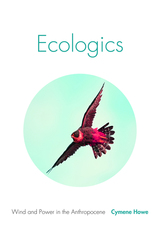 Ecologics: Wind and Power in the Anthropocene
Cymene Howe
Duke University Press, 2019 Between 2009 and 2013 Cymene Howe and Dominic Boyer conducted fieldwork in Mexico's Isthmus of Tehuantepec to examine the political, social, and ecological dimensions of moving from fossil fuels to wind power. Their work manifested itself as a new ethnographic form: the duograph—a combination of two single-authored books that draw on shared fieldsites, archives, and encounters that can be productively read together, yet can also stand alone in their analytic ambitions.
In her volume, Ecologics, Howe narrates how an antidote to the Anthropocene became both failure and success. Tracking the development of what would have been Latin America's largest wind park, Howe documents indigenous people's resistance to the project and the political and corporate climate that derailed its renewable energy potential. Using feminist and more-than-human theories, Howe demonstrates how the dynamics of energy and environment cannot be captured without understanding how human aspirations for energy articulate with nonhuman beings, technomaterial objects, and the geophysical forces that are at the heart of wind and power.
Ecologies of a Storied Planet in the Anthropocene
Serpil Oppermann
West Virginia University Press, 2023 A more-than-human approach to planetary survival, from a leading environmental humanist.
Ecologies of a Storied Planet in the Anthropocene is a tour de force. With transdisciplinarity and theoretical lucidity, it rethinks the Anthropocene from a material ecocritical perspective, envisioning innovative modes of knowledge for deeper understandings of Anthropocene ecologies. Focusing on nonhuman agencies, Serpil Oppermann shows in fascinating detail how to better imagine an ecological future on our storied planet that has suffered enormously from an anthropocentric mindset.
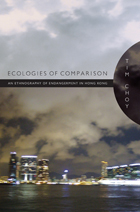 Ecologies of Comparison: An Ethnography of Endangerment in Hong Kong
Tim Choy
Duke University Press, 2011 A rich ethnography of ecopolitics in Hong Kong in the late 1990s, as the region shifted to Chinese sovereignty, Ecologies of Comparison describes how ecological concepts of uniqueness and scale resonated among environmentalists, including those seeking to preserve a species of white dolphin, to protect an aging fishing village from redevelopment, and to legitimize air quality as an object of political and medical concern. During his research, Tim Choy became increasingly interested in the power of the notion of specificity. While documenting the expert and lay production of Hong Kong’s biological, cultural, and political specificities, he began comparing the logics and narrative forms that made different types of specificity—such as species, culture, locality, and state autonomy—possible and meaningful. He came to understand these logics and forms as “ecologies of comparison,” conceptual practices through which an event or form of life comes to matter in environmentalist and other political terms. Choy’s ethnography is about environmentalism, Hong Kong, and the ways that we think about environmentalism in Hong Kong and other places. It is also about how politics, freedom, culture, expertise, and other concepts figure in comparison-based knowledge practices.
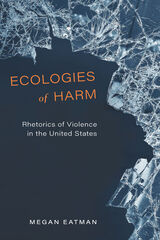 Ecologies of Harm: Rhetorics of Violence in the United States
Megan Eatman
Ohio State University Press, 2020 Ecologies of Harm: Rhetorics of Violence in the United States examines violent spectacles and their quotidian manifestations in order to better understand violence’s cultural work and persistence. Starting with the supposition that violence is communicative andmeant to “send a message”—be it to deter, to scare, or to threaten—Megan Eatman goes one step further to argue that violence needs to be understood on a deeper level: as direct, structural, cultural, and constitutive across modes, a formulation that requires rethinking its rhetorical aims as less about conscious persuasion and more about the gradual shaping of public identity.
While Eatman looks to examples of violent spectacles to make her case (lynching, capital punishment, and torture in the War on Terror), it is in her analysis of more mundane responses to these forms of violence (congressional debates, court documents, visual art, and memorial performance) where the key to her argument lies—as she shows how circulating violence in these ways produces violent rhetorical ecologies that facilitate some modes of being while foreclosing others. Through this ecological approach, Ecologies of Harm offers a new understanding of the debates surrounding legacies of violence, examines how rhetoric and violence function together, and explores implications of their entanglement for antiviolence work.
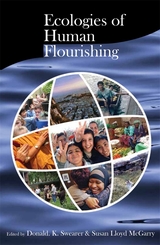 Ecologies of Human Flourishing
Donald K. Swearer
Harvard University Press In this volume, prominent Buddhist scholar Donald Swearer posits that the future requires a radical shift toward living in recognition of the interdependence of all life forms and the consequent ethic of communality and a life style of moderation or “enoughness” that flows from that recognition, which he calls “an ecology of human flourishing.” Swearer has assembled world-class thinkers to explore and imagine several dimensions of an ecology of human flourishing: economic, sociological, religious, ethical, environmental, historical, literary; how notions of human flourishing, quality of life, and common good have been constructed; and, in the contemporary world, how they are illuminated or are challenged by issues of distributive justice, poverty and economic inequality, global health, and environmental sustainability.
With contributors ranging from ecoactivist Bill McKibben and medical anthropologist Arthur Kleinman, to transformative theologian Sallie McFague and Malaysian critic of global injustice Chandra Muzzafar, this book expresses ethical and religious aspirations to remake the world in the midst of the contradictions, injustices, and problems of our daily lives and today's global economic and climate crises.
Ecologies of Translation in East and South East Asia, 1600-1900
Li Guo
Amsterdam University Press, 2022 This ground-breaking volume on early modern inter-Asian translation examines how translation from plain Chinese was situated at the nexus between, on the one hand, the traditional standard of biliteracy characteristic of literary practices in the Sinographic sphere, and on the other, practices of translational multilingualism (competence in multiple spoken languages to produce a fully localized target text). Translations from plain Chinese are shown to carve out new ecologies of translations that not only enrich our understanding of early modern translation practices across the Sinographic sphere, but also demonstrate that the transregional uses of a non-alphabetic graphic technology call for different models of translation theory.
Ecologism: An Introduction
Brian Baxter
Georgetown University Press Ecologism is a new political ideology based on the position that the non-human world is worthy of moral consideration, and that this should be taken into account in social, economic, and political systems. This innovative book provides the first comprehensive introduction to this philosophy, which is recognized as a major development in environmental politics. Brian Baxter probes the metaphysical, moral, political, and economic facets of ecologism. Bringing the central themes of contemporary political theory into contact with green political theory, he compares ecologism to such mainstream ideologies as utilitarianism, Rawlsian liberalism, libertarianism, Marxism, and feminism. An innovative contribution to environmental ethics and political philosophy, this book provides new insights into and solutions to the problematic relationship between society and nature.
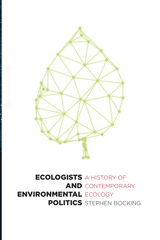 Ecologists and Environmental Politics: A History of Contemporary Ecology
Stephen Bocking
West Virginia University Press, 2017 Ecologists, like other scientists, have for decades debated their role in society. While some have argued that ecologists should participate in environmental politics, others have focused their attention strictly on scientific issues. In Ecologists and Environmental Politics, now updated with a new preface by the author, Stephen Bocking explores this debate by recounting the history of ecology in Great Britain, the United States, and Canada since the 1940s.
Bocking tells this history through four case studies: the origins and early research of the Nature Conservancy in Great Britain; the development of ecology at the Oak Ridge National Laboratory in Tennessee; the work of the Hubbard Brook Ecosystem Study in New Hampshire; and research in fisheries ecology at the University of Toronto. By comparing these case studies, Bocking demonstrates how the places of contemporary science—laboratories, landscapes, and funding agencies—and science’s purposes, as expressed through the political roles of expertise and specific managerial and regulatory responsibilities, have shaped contemporary ecology and its application to pressing environmental problems.
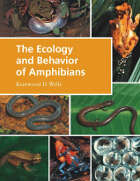 The Ecology and Behavior of Amphibians
Kentwood D. Wells
University of Chicago Press, 2007 Consisting of more than six thousand species, amphibians are more diverse than mammals and are found on every continent save Antarctica. Despite the abundance and diversity of these animals, many aspects of the biology of amphibians remain unstudied or misunderstood. The Ecology and Behavior of Amphibians aims to fill this gap in the literature on this remarkable taxon. It is a celebration of the diversity of amphibian life and the ecological and behavioral adaptations that have made it a successful component of terrestrial and aquatic ecosystems.
Synthesizing seventy years of research on amphibian biology, Kentwood D. Wells addresses all major areas of inquiry, including phylogeny, classification, and morphology; aspects of physiological ecology such as water and temperature relations, respiration, metabolism, and energetics; movements and orientation; communication and social behavior; reproduction and parental care; ecology and behavior of amphibian larvae and ecological aspects of metamorphosis; ecological impact of predation on amphibian populations and antipredator defenses; and aspects of amphibian community ecology. With an eye towards modern concerns, The Ecology and Behavior of Amphibians concludes with a chapter devoted to amphibian conservation.
An unprecedented scholarly contribution to amphibian biology, this book is eagerly anticipated among specialists.
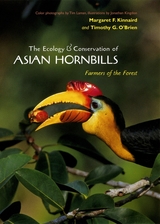 The Ecology and Conservation of Asian Hornbills: Farmers of the Forest
Margaret F. Kinnaird and Timothy G. O'Brien
University of Chicago Press, 2008 Hornbills are among the world’s most distinct birds. Easily recognized by their oversized beaks adorned with large casques, they range from Africa to India and throughout Asia. One of the oldest bird orders, they have been known to mankind for millennia and loom large in the mythology of indigenous cultures of tropical Asia. In the past thirty years, ecologists have uncovered many fascinating aspects of hornbill biology, from their unique nest-sealing behavior to their roles as farmers of the forest.
Building on fourteen years of research, Margaret F. Kinnaird and Timothy G. O’Brien offer in Ecology and Conservation of Asian Hornbills the most up-to-date information on the evolution, reproduction, feeding ecology, and movement patterns of thirty-one species of Asian hornbills. The authors address questions of ecological functionality, ecosystem services, and keystone relationships, as well as the disturbing influence of forest loss and fragmentation on hornbills. Complemented by superb full-color images by renowned photographer Tim Laman that provide rare glimpses of hornbills in their native habitat and black-and-white illustrations by Jonathan Kingdon that highlight the intriguing aspects of hornbill behavior, Ecology and Conservation of Asian Hornbills will stand tall in the pantheon of natural history studies for years to come.
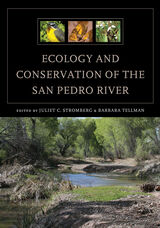 Ecology and Conservation of the San Pedro River
Edited by Juliet C. Stromberg and Barbara Tellman
University of Arizona Press, 2009 One of the last undammed perennial rivers in the desert Southwest, the San Pedro River in southeastern Arizona illustrates important processes common to many desert riparian ecosystems. Although historic land uses and climatic extremes have led to aquifer depletion, river entrenchment, and other changes, the river still sustains a rich and varied selection of life. Resilient to many factors, portions of the San Pedro have become increasingly threatened by groundwater pumping and other impacts of population growth.
This book provides an extensive knowledge base on all aspects of the San Pedro, from flora and fauna to hydrology and human use to preservation. It describes the ecological patterns and processes of this aridland river and explores both the ongoing science-driven efforts by nonprofit groups and government agencies to sustain and restore its riparian ecosystems and the science that supports these management decisions.
An interdisciplinary team of fifty-seven contributors—biologists, ecologists, geomorphologists, historians, hydrologists, lawyers, political scientists—weave together threads from their diverse perspectives to reveal the processes that shape the past, present, and future of the San Pedro’s riparian and aquatic ecosystems. They review the biological communities of the San Pedro and the stream hydrology and geomorphology that affect its riparian biota. They then look at conservation and management challenges along three sections of the San Pedro, from its headwaters in Mexico to its confluence with the Gila River, describing legal and policy issues and their interface with science; activities related to mitigation, conservation, and restoration; and a prognosis of the potential for sustaining the basin’s riparian system.
These chapters demonstrate the complexity of the San Pedro’s ecological and hydrological conditions, showing that there are no easy answers to the problems—and that existing laws are inadequate to fully address them. Collectively, they offer students, professionals, and environmental advocates a better grasp of the San Pedro’s status as well as important lessons for restoring physical processes and biotic communities to rivers in arid and semiarid regions.
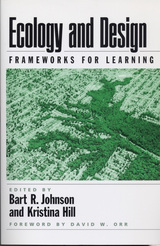 Ecology and Design: Frameworks For Learning
Edited by Bart Johnson and Kristina Hill; Foreword by Robert Melnick
Island Press, 2001 Professionals, faculty, and students are aware of the pressing need to integrate ecological principles into environmental design and planning education, but few materials exist to facilitate that development. Ecology and Design addresses that shortcoming by articulating priorities and approaches for incorporating ecological principles in the teaching of landscape design and planning. The book explains why landscape architecture and design and planning faculty should include ecology as a standard part of their courses and curricula, provides insights on how that can be done, and offers models from successful programs. The book: - examines the need for change in the education and practice of landscape architecture and in the physical planning and design professions as a whole
- asks what designers and physical planners need to know about ecology and what applied ecologists can learn from design and planning
- develops conceptual frameworks needed to realize an ecologically based approach to design and planning
- offers recommendations for the integration of ecology within a landscape architecture curriculum, as an example for other design fields such as civil engineering and architecture
- considers the implications for professional practice
- explores innovative approaches to collaboration among designers and ecologists
In addition to the editors, contributors include Carolyn Adams, Jack Ahern, Richard T. T. Forman, Michael Hough, James Karr, Joan Iverson Nassauer, David Orr, Kathy Poole, H. Ronald Pulliam, Anne Whiston Spirn, Sandra Steingraber, Carl Steinitz, Ken Tamminga, and William Wenk. Ecology and Design represents an important guidepost and source of ideas for faculty, students, and professionals in landscape architecture, urban design, planning and architecture, landscape ecology, conservation biology and restoration ecology, civil and environmental engineering, and related fields.
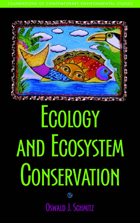 Ecology and Ecosystem Conservation
Oswald J. Schmitz
Island Press, 2007 Meeting today’s environmental challenges requires a new way of thinking about the intricate dependencies between humans and nature. Ecology and Ecosystem Conservation provides students and other readers with a basic understanding of the fundamental principles of ecological science and their applications, offering an essential overview of the way ecology can be used to devise strategies to conserve the health and functioning of ecosystems. The book begins by exploring the need for ecological science in understanding current environmental issues and briefly discussing what ecology is and isn’t. Subsequent chapters address critical issues in conservation and show how ecological science can be applied to them. The book explores questions such as: • What is the role of ecological science in decision making?
• What factors govern the assembly of ecosystems and determine their response to various stressors?
• How does Earth’s climate system function and determine the distribution of life on Earth?
• What factors control the size of populations?
• How does fragmentation of the landscape affect the persistence of species on the landscape?
• How does biological diversity influence ecosystem processes? The book closes with a final chapter that addresses the need not only to understand ecological science, but to put that science into an ecosystem conservation ethics perspective.
 Ecology and Environmental Management of Lyme Disease
Ginsberg, Howard S
Rutgers University Press, 1993 Lyme disease--virtually unknown in the United States only a decade ago--has now been reported from almost every state; in the Northeast, it has become a major public health crisis. Under the name of borreliosis, the disease is also common in Europe. As Americans have become aware of the hazard they face from Lyme disease, they have become anxious to know how to avoid or control the disease. But the complex ecological interactions of Lyme disease make that extremely difficult. The disease is caused by a microorganism, a spirochete, which is carried by tiny ticks. The ticks, in turn, are transported from place to place by their hosts: humans, deer, white-tailed mice, dogs, lizards, and many other animals and birds. Both ticks and their hosts serve as a reservoir for the disease. As with any tick-borne disease, the best hope of prevention lies in understanding and interrupting the lifecycle of the microorganism, its vectors, and their hosts.
This book is the first attempt to survey the natural history, ecology, population dynamics, geography, and environmental management of Lyme disease. Eighteen leading American researchers on Lyme disease explain the current state of knowledge and comment candidly on the theoretical and practical advantages and difficulties with each technique of surveillance, self-protection, and tick control. The book includes suggestions for personal protection against the disease,
This is an essential resource for naturalists, ecologists, physicians, nurses, epidemiologists, public health officials, entomologists, veterinarians, pest control operators, wildlife managers, town planners, and anyone concerned with Lyme disease.
Ecology and Evolution in the Tropics: A Herpetological Perspective
Edited by Maureen A. Donnelly, Brian I. Crother, Craig Guyer, Marvalee H. Wake,
University of Chicago Press, 2005 In these essays that survey the burgeoning field of tropical herpetology, former students and associates pay tribute to Jay Savage's four decades of mentoring. The result is a book unlike any other available in tropical herpetology. Covering a wide array of subjects, Ecology and Evolution in the Tropics is the first book in more than two decades to broadly review research on tropical amphibians and reptiles. A tribute to Savage and an invaluable addition to the herpetological literature, this work will be cited for years to come.
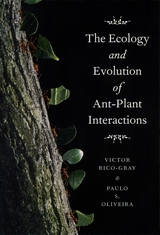 The Ecology and Evolution of Ant-Plant Interactions
Victor Rico-Gray and Paulo S. Oliveira
University of Chicago Press, 2007 Ants are probably the most dominant insect group on Earth, representing ten to fifteen percent of animal biomass in terrestrial ecosystems. Flowering plants, meanwhile, owe their evolutionary success to an array of interspecific interactions—such as pollination, seed dispersal, and herbivory—that have helped to shape their great diversity. The Ecology and Evolution of Ant-Plant Interactions brings together findings from the scientific literature on the coevolution of ants and plants to provide a better understanding of the unparalleled success of these two remarkable groups, of interspecific interactions in general, and ultimately of terrestrial biological communities.
The Ecology and Evolution of Ant-Plant Interactions synthesizes the dynamics of ant-plant interactions, including the sources of variation in their outcomes. Victor Rico-Gray and Paulo S. Oliveira capture both the emerging appreciation of the importance of these interactions within ecosystems and the developing approaches that place studies of these interactions into a broader ecological and evolutionary context. The collaboration of two internationally renowned scientists, The Ecology and Evolution of Ant-Plant Interactions will become a standard reference for understanding the complex interactions between these two taxa.
 Ecology and Evolution of Communities
Martin Cody and Jared Diamond
Harvard University Press, 1975 In recent times, the science of ecology has been rejuvenated and has moved to a central position in biology. This volume contains eighteen original, major contributions by leaders in the field, all associates of the late Robert MacArthur, whose work has stimulated many of the recent developments in ecology. The intellectual ferment of the field is reflected in these papers, which offer new models for ecological processes, new applications of theoretical and quantitative techniques, and new methods for analyzing and interpreting a wide variety of empirical data.
The first five chapters explore the evolution of species abundance and diversity (R. Levins, E. Leigh, J. MacArthur, R. May, and M. Rosenzweig). The theory of loop analysis is newly applied to understanding stability of species communities under both mendelian and group selection. Species abundance relations, population fluctuations, and continental patterns of species diversity are illustrated and interpreted theoretically. The next section examines the competitive strategies of optimal resource allocation variously employed in plant life histories (W. Schaffer and M. Gadgil), bird diets and foraging techniques (H. Hespenheide), butterfly seasonal flights (A. Shapiro), and forest succession examined by the theory of Markov processes (H. Horn).
The seven chapters of the third section study the structure of species communities, by comparing different natural communities in similar habitats (M. Cody, J. Karr and F. James, E. Pianka, J. Brown, J. Diamond), or by manipulating field situations experimentally (R. Patrick, J. Connell). The analyses are of communities of species as diverse as freshwater stream organisms, desert lizards and rodents, birds, invertebrates, and plants. These studies yield insights into the assembly of continental and insular communities, convergent evolution of morphology and of ecological structure, and the relative roles of predation, competition, and harsh physical conditions in limiting species ranges.
Finally, the two remaining chapters illustrate how ecological advances depend on interaction of theory with field and laboratory observations (G. E. Hutchinson), and how ecological studies such as those of this volume may find practical application to conservation problems posed by man's accelerating modification of the natural world (E. Wilson and E. Willis).
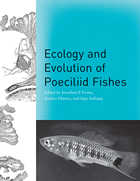 Ecology and Evolution of Poeciliid Fishes
Edited by Jonathan P. Evans, Andrea Pilastro, and Ingo Schlupp
University of Chicago Press, 2011 The history of biology is populated by numerous model species or organisms. But few vertebrate groups have aided evolutionary and ecological research more than the live-bearing fishes of the family Poeciliidae. Found throughout tropical and subtropical waters, poeciliids exhibit a fascinating variety of reproductive specializations, including viviparity, matrotrophy, unisexual reproduction, and alternative mating strategies, making them ideal models for research on patterns and processes in ecology, behavior, and evolution.
Ecology and Evolution of Poeciliid Fishes is a much-needed overview of the scientific potential and understanding of these live-bearing fishes. Chapters by leading researchers take up a wide range of topics, including the evolution of unisexual reproduction, life in extreme environments, life-history evolution, and genetics. Designed to provide a single and highly approachable reference, Ecology and Evolution of Poeciliid Fishes will appeal to students and specialists interested in all aspects of evolutionary ecology.
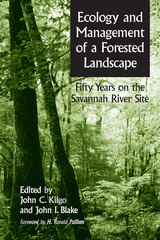 Ecology and Management of a Forested Landscape: Fifty Years on the Savannah River Site
Edited by John C. Kilgo and John I. Blake; Foreword by H. Ronald Pulliam
Island Press, 2005 Can land degraded by centuries of agriculture be restored to something approaching its original productivity and diversity? This book tells the story of fifty years of restoration and management of the forested landscape of the Savannah River Site, a 310-square-mile tract of land in the coastal plain of South Carolina that has been closed to the public for more than five decades. Ecology and Management of a Forested Landscape presents for the first time a complete synthesis and summary of information on the Savannah River Site, providing a detailed portrait of the plant and animal populations and communities on the site and the effects on them of fifty years of management practices. Contributors offer thirty-two chapters that describe the site's history, land management, physical environment, plant and animal communities, endangered species, and game species. Extensively illustrated with photos, maps, charts, and tables, the book provides a comprehensive overview of the forest management practices that can support long-term forest recovery and restoration of native habitats. It represents for natural resource managers a detailed case study in long-term land management, and provides scientists with an in-depth analysis of the natural history and physical and biological characteristics of a southeastern forested landscape.
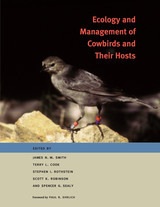 Ecology and Management of Cowbirds and Their Hosts: Studies in the Conservation of North American Passerine Birds
By James N. M. Smith, Terry L. Cook, Stephen I. Rothstein, Scott K. Robinson, and Spencer G. Sealy
University of Texas Press, 2000 In the past two centuries, cowbirds have increased in numbers and extended their range across North America, while many of the native songbird species whose nests they parasitize to raise their young have declined. This timely book collects forty essays by most of the principal authorities on the biology and management of cowbirds. The book's goals are to explore the biology of cowbirds, the threats they pose to host species and populations, and the management programs that are being undertaken to minimize these threats. The book is organized into five sections, each with an extended editors' introduction that places the contributions in a broad, up-to-date setting. The sections cover: - The changing abundance of cowbirds and the ways in which their numbers can be estimated.
- Host choice by cowbirds, the negative effects of cowbirds on particular host species, and the daily patterns of cowbird behavior.
- Behavioral interactions between cowbirds and specific host species.
- Patterns of cowbird abundance and host use across varying landscapes.
- Management programs designed to control cowbirds and protect threatened songbirds.
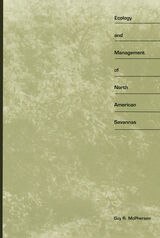 Ecology and Management of North American Savannas
Guy R. McPherson
University of Arizona Press, 1997 Savannas are ecosytems with a continuous grass layer and scattered trees or shrubs. These lands occupy nearly a third of the earth’s land surface and are an important resource not only in world economies but also as repositories of biodiversity. Because savannas are generally thought of as tropical ecosystems, most reviews of the literature have tended to disregard savannas found in temperate zones. Yet these ecosystems are both extensive and diverse in North America, ranging from longleaf pine habitats along the Atlantic coastal plain to xeric piñon-juniper communities of the Great Basin-ecosystems seemingly disparate, yet similar enough to merit study as savannas. This book provides an overview of the patterns and processes shared by these ecosystems and offers substantive ideas regarding future management and research efforts. It describes the composition geographic distribution, climate, soils, and uses of savannas throughout North America, summarizing and integrating a wide array of literature. While discussing these ecological patterns and processes. McPherson develops a framework for implementing management practices and safeguarding the future of these important wildland ecosystems. Ecology and Management of North American Savannas takes a major step toward establishing the science of savanna ecology for North America. It encourages constructive debate and relevant research on these important systems and will also serve as a useful resource in biogeography, plant ecology, and rangeland management.
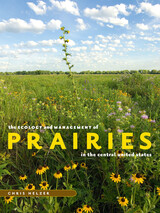 The Ecology and Management of Prairies in the Central United States
Chris Helzer
University of Iowa Press, 2010 Most prairies exist today as fragmented landscapes, making thoughtful and vigilant management ever more important. Intended for landowners and managers dedicated to understanding and nurturing their prairies as well as farmers, ranchers, conservationists, and all those with a strong interest in grasslands, ecologist Chris Helzer’s readable and practical manual educates prairie owners and managers about grassland ecology and gives them guidelines for keeping prairies diverse, vigorous, and viable.
Chapters in the first section, "Prairie Ecology," describe prairie plants and the communities they live in, the ways in which disturbance modifies plant communities, the animal and plant inhabitants that are key to prairie survival, and the importance of diversity within plant and animal communities. Chapters in the second section, "Prairie Management," explore the adaptive management process as well as guiding principles for designing management strategies, examples of successful management systems such as fire and grazing, guidance for dealing with birds and other species that have particular habitat requirements and with the invasive species that have become the most serious threat that prairie managers have to deal with, and general techniques for prairie restoration. Following the conclusion and a forward-thinking note on climate change, eight appendixes provide more information on grazing, prescribed fire, and invasive species as well as bibliographic notes, references, and national and state organizations with expertise in prairie management.
Grasslands can be found throughout much of North America, and the ideas and strategies in this book apply to most of them, particularly tallgrass and mixed-grass prairies in eastern North Dakota, eastern South Dakota, eastern Nebraska, eastern Kansas, eastern Oklahoma, northwestern Missouri, northern Illinois, northwestern Indiana, Iowa, southwestern Wisconsin, and southwestern Minnesota. By presenting all the factors that promote biological diversity and thus enhance prairie communities, then incorporating these factors into a set of clear-sighted management practices, The Ecology and Management of Prairies in the Central United States presents the tools necessary to ensure that grasslands are managed in the purposeful ways essential to the continued health and survival of prairie communities.
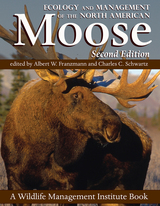 Ecology and Management of the North American Moose, Second Edition
Charles C. Schwartz
University Press of Colorado, 2007 Back in print as a University Press of Colorado edition, this abundantly illustrated volume with field sketch illustrations by William D. Berry fully explains moose biology and ecology and assesses the increasingly complex enterprise of managing moose. Twenty-one of the world's authorities on the species discuss its taxonomy, reproduction and growth, feeding habits, behavior, population dynamics, relationships with predators, incidental mortality, seasonal migration patterns, and habitat and harvest management. Contributors include Warren B. Ballard, Arnold H. Boer, Anthony B. Bubenik, M. E. Buss, Kenneth N. Child, Vincent F.J. Crichton, Albert W. Franzmann, Kris J. Hundertmark, Patrick D. Karns, Murray W. Lankester, Richard E. McCabe, James M. Peek, Henry M. Reeves, Wayne L. Regelin, Lyle A. Renecker, William M. Samuel, Charles C. Schwartz, Robert W. Stewart, Ian D. Thompson, H. R. Timmermann, and Victor Van Ballenberghe. A Wildlife Management Institute book
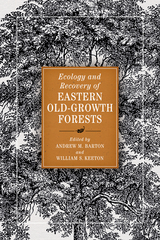 Ecology and Recovery of Eastern Old-Growth Forests
Edited by Andrew M. Barton and William S. Keeton
Island Press, 2018 The landscapes of North America, including eastern forests, have been shaped by humans for millennia, through fire, agriculture, hunting, and other means. But the arrival of Europeans on America’s eastern shores several centuries ago ushered in the rapid conversion of forests and woodlands to other land uses. By the twentieth century, it appeared that old-growth forests in the eastern United States were gone, replaced by cities, farms, transportation networks, and second-growth forests. Since that time, however, numerous remnants of eastern old growth have been discovered, meticulously mapped, and studied. Many of these ancient stands retain surprisingly robust complexity and vigor, and forest ecologists are eager to develop strategies for their restoration and for nurturing additional stands of old growth that will foster biological diversity, reduce impacts of climate change, and serve as benchmarks for how natural systems operate.
Forest ecologists William Keeton and Andrew Barton bring together a volume that breaks new ground in our understanding of ecological systems and their importance for forest resilience in an age of rapid environmental change. This edited volume covers a broad geographic canvas, from eastern Canada and the Upper Great Lakes states to the deep South. It looks at a wide diversity of ecosystems, including spruce-fir, northern deciduous, southern Appalachian deciduous, southern swamp hardwoods, and longleaf pine. Chapters authored by leading old-growth experts examine topics of contemporary forest ecology including forest structure and dynamics, below-ground soil processes, biological diversity, differences between historical and modern forests, carbon and climate change mitigation, management of old growth, and more.
This thoughtful treatise broadly communicates important new discoveries to scientists, land managers, and students and breathes fresh life into the hope for sensible, effective management of old-growth stands in eastern forests.
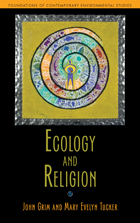 Ecology and Religion
John Grim and Mary Evelyn Tucker
Island Press, 2014 From the Psalms in the Bible to the sacred rivers in Hinduism, the natural world has been integral to the world’s religions. John Grim and Mary Evelyn Tucker contend that today’s growing environmental challenges make the relationship ever more vital.
This primer explores the history of religious traditions and the environment, illustrating how religious teachings and practices both promoted and at times subverted sustainability. Subsequent chapters examine the emergence of religious ecology, as views of nature changed in religious traditions and the ecological sciences. Yet the authors argue that religion and ecology are not the province of institutions or disciplines alone. They describe four fundamental aspects of religious life: orienting, grounding, nurturing, and transforming. Readers then see how these phenomena are experienced in a Native American religion, Orthodox Christianity, Confucianism, and Hinduism.
Ultimately, Grim and Tucker argue that the engagement of religious communities is necessary if humanity is to sustain itself and the planet. Students of environmental ethics, theology and ecology, world religions, and environmental studies will receive a solid grounding in the burgeoning field of religious ecology.
 Ecology and the Environment: Perspectives from the Humanities
Donald K. Swearer
Harvard University Press, 2009 The scientific, political, and economic policy debates about the global environmental crisis have tended to ignore its historical, ethical, religious, and aesthetic dimensions. This book redresses that omission by highlighting these humanistic components that are integral to the fabric of our ecological understanding and, consequentially, essential to a broad, multidisciplinary approach to environmental studies and public policy initiatives.
In this slim volume, seven world-class scholars discuss the wide range of perspectives that the fields of literature, history, religion, philosophy, environmental ethics, and anthropology bring to the natural environment and our place in it. The preface summarizes the development of the religion and ecology movement; the editor’s critical introduction highlights the essays’ major themes. Bringing insights from the humanities to bear on ecological concerns, this volume will appeal to a wide audience in the humanities and environmental studies, policy makers, and the general public. The book represents a continuation of the Center for the Study of World Religions’ highly regarded Religions of the World and Ecology series.
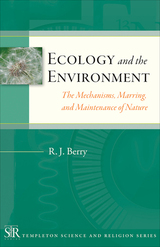 Ecology and the Environment: The Mechanisms, Marrings, and Maintenance of Nature
R. J. Berry
Templeton Press, 2011 Ecology and the Environment: The Mechanisms, Marring, and Maintenance of Nature is the ninth title published in the Templeton Science and Religion Series, in which scientists from a wide range of fields distill their experience and knowledge into brief tours of their respective specialties. In this volume, R. J. Berry, a well-known leader in the field of ecology, describes the basic concepts of ecology and seeks to put them into a general context for a reader who lacks any scientific background. Berry explores the implications of these basic concepts and how they affect human life and the decisions we have to make, both as individuals and as members of a species that has colonized and influenced every part of the globe. He points out that we are a part of the animal world, but at the same time, we are apart from it, and he makes it clear that how we relate to our environment affects the quality of our life—indeed, it may affect our very survival. Going beyond a simple introduction of concepts, the book explores wider questions about the nature of humanity and how human ecology relates to humanness. Berry proposes that we are more than machines or even advanced apes—we are Homo divinus, transformed from an organism descended from the same stock as the apes but qualitatively different and able to relate to a creator God. The book argues that those who conclude otherwise are neglecting relevant data. Berry offers the perfect introduction to these philosophical and theological issues, but his work never loses sight of the practical issues either—the kind that is increasingly being addressed by national and international environmental agencies. In order to grasp the full scope of these issues and to more fully understand the ubiquitous news headlines concerning environmental matters, a reader would do well to start with Ecology and the Environment.
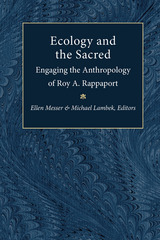 Ecology and the Sacred: Engaging the Anthropology of Roy A. Rappaport
Ellen Messer and Michael Lambek, Editors
University of Michigan Press, 2001 Ecology and the Sacred commemorates and advances the anthropology of Roy A. (Skip) Rappaport. Rappaport was an original and visionary thinker whose writings, like these essays, encompass ecological theory and method; ritual, the sacred, and the cybernetics of the holy; the structural study of social maladaptation or "the anthropology of trouble"; and a policy-engaged anthropology that addresses social complexity and structural disorders in modern contexts. The contributors, who are leaders in anthropological studies of the environment and of religion, address themes emerging from Rappaport's pioneering ethnography of Papua New Guinea through his engagement with contemporary social problems. In addition to presenting significant new ethnographic data and sharp critical perspectives, the collection demonstrates the essential holism of anthropology as represented by Rappaport's contributions and legacy.
At a time when anthropology is fractured by debates over whether it is a science or a humanistic tradition, theoretical or applied, this festschrift testifies that a unified anthropology is both possible and necessary for the understanding of humanity and global transformations. The volume will be of interest not only to anthropologists, but to geographers, sociologists, scholars in science-studies, historians, and experts and practitioners in religious studies, as well.
Ellen Messer is Visiting Associate Professor, Tufts University. Michael Lambek is Professor of Anthropology, University of Toronto.
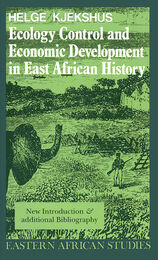 Ecology Control and Economic Development in East African History: The Case of Tanganyika, 1850–1950
Helge Kjekshus
Ohio University Press, 1995 This pioneering book was one of the first to place the history of East Africa within the context of the environment. It has been used continuously for student teaching. It is now reissued with an introduction placing it within the debate that has developed on the subject; there is also an updated bibliography.
The book puts people at the centre of events. It thus serves as a modification to nationalist history with its emphasis on leaders. It presents environmental factors that had been underestimated; for instance, it points to the critical importance of the rinderpest outbreak.
Helge Kjekshus provides evidence to suggest that the nineteenth century was a period of relative prosperity with well-developed trade. He questions the view that warfare was pervasive and that the slave trade led to depopulation. He points to a balance between man and the environment.
This book is reissued at the same time as the first publication of Custodians of the Land: Ecology and Culture in the History of Tanzania edited by Gregory Maddox, James I. Giblin and Isaria N. Kimambo. The footnotes in that book point to the importance of the work of Helge Kjekshus.
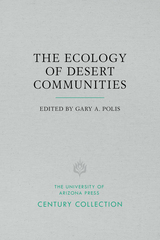 The Ecology of Desert Communities
Edited by Gary A. Polis
University of Arizona Press, 1991 "Provides interesting and thought-provoking reading and is highly recommended to anyone interested in desert ecosystems or community ecology. The book . . . should serve as an inspiration to many for future research."—Journal of Biogeography
"This book is not just about deserts; it is an update of the contributions that research in desert systems is making to community ecology. . . This book will provide a useful reference for desert ecologists, as well as indicate critical directions where progress needs to be made."—Ecology
"This important book fills a significant gap in previous syntheses by presenting a detailed series of reviews of current understanding of community patterns and structure in desert environments. . . . Each chapter is thorough and well written and . . . closes with a discussion of suggested future research. . . . [T]hese ideas will do much to focus interest on the importance of desert systems in understanding community. Thus, this book has interest well beyond desert ecologists alone."—BioScience
"Valuable reading and reference for ecology students, teachers and researchers."—Quarterly Review of Biology
 The Ecology of Ecologists: Harnessing Diverse Approaches for a Stronger Science
Jeremy Fox
University of Chicago Press, 2025 A celebration of ecology’s variety—as both subject and research endeavor—and a call for intradisciplinary understanding.
Open any ecology textbook, and you will find a heterogeneous mix of material that puzzles many newcomers. How do levels of organization from individual organisms to ecosystems, abstract concepts like food webs and biodiversity, and applied topics, like climate change and conservation, all fit together? New ecological research can be equally puzzling. Ecology journals publish studies using different methods in different study systems to ask different questions and achieve different goals. Is this all really Ecology? Yes, ecologist Jeremy Fox says in this eye-opening book. Ecology contains multitudes, and that is its power. In an essential book for all ecologists, Fox builds on insights developed in his popular blog, Dynamic Ecology, to argue that it is better for a scientific discipline to be messy than monolithic.
Analyzing and accessibly explaining a broad range of scientific literature, Fox shows that ecology grew from disparate sources with profoundly different motivations, methods, and goals. We see the differences in those origins reflected in today’s research, in the pull between those who want to establish ecological laws akin to physical ones and those who see ecology’s value as inherent in its species- or system-specific case studies. Neither group, Fox argues, is doing ecology wrong. Instead, he says, the strength of this science—as in most ecological systems—is diversity. It is good when two ecologists look at similar problems differently. We now need the community to know enough about those different approaches to improve how they work together.
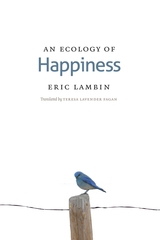 An Ecology of Happiness
Eric Lambin
University of Chicago Press, 2012 We know that our gas-guzzling cars are warming the planet, the pesticides and fertilizers from farms are turning rivers toxic, and the earth has run out of space for the mountains of unrecycled waste our daily consumption has left in its wake. We’ve heard copious accounts of our impact—as humans, as a society—on the natural world. But this is not a one-sided relationship. Lost in these dire and scolding accounts has been the impact on us and our well-being. You sense it while walking on a sandy beach, or in a wild, woody forest, or when you catch sight of wildlife, or even while gardening in your backyard. Could it be that the natural environment is an essential part of our happiness? Yes, says Eric Lambin emphatically in An Ecology of Happiness. Using a very different strategy in addressing environmental concerns, he asks us to consider that there may be no better reason to value and protect the health of the planet than for our own personal well-being.
In this clever and wide-ranging work, Lambin draws on new scientific evidence in the fields of geography, political ecology, environmental psychology, urban studies, and disease ecology, among others, to answer such questions as: To what extent do we need nature for our well-being? How does environmental degradation affect our happiness? What can be done to protect the environment and increase our well-being at the same time? Drawing on case studies from Asia, Africa, Europe, and North America, Lambin makes a persuasive case for the strong link between healthy ecosystems and happy humans.
Unique in its scope and evenhanded synthesis of research from many fields, An Ecology of Happiness offers a compelling human-centered argument that is impossible to overlook when we marvel at murmurations of starlings or seek out the most brilliant fall foliage: nature makes our steps a little lighter and our eyes a little brighter. What better reason to protect an ecosystem or save a species than for our own pleasure?
 The Ecology of Human Development: Experiments by Nature and Design
Urie Bronfenbrenner
Harvard University Press, 1979 Here is a book that challenges the very basis of the way psychologists have studied child development. According to Urie Bronfenbrenner, one of the world’s foremost developmental psychologists, laboratory studies of the child’s behavior sacrifice too much in order to gain experimental control and analytic rigor. Laboratory observations, he argues, too often lead to “the science of the strange behavior of children in strange situations with strange adults for the briefest possible periods of time.” To understand the way children actually develop, Bronfenbrenner believes that it will be necessary to observe their behavior in natural settings, while they are interacting with familiar adults over prolonged periods of time.
This book offers an important blueprint for constructing such a new and ecologically valid psychology of development. The blueprint includes a complete conceptual framework for analysing the layers of the environment that have a formative influence on the child. This framework is applied to a variety of settings in which children commonly develop, ranging from the pediatric ward to daycare, school, and various family configurations. The result is a rich set of hypotheses about the developmental consequences of various types of environments. Where current research bears on these hypotheses, Bronfenbrenner marshals the data to show how an ecological theory can be tested. Where no relevant data exist, he suggests new and interesting ecological experiments that might be undertaken to resolve current unknowns.
Bronfenbrenner’s groundbreaking program for reform in developmental psychology is certain to be controversial. His argument flies in the face of standard psychological procedures and challenges psychology to become more relevant to the ways in which children actually develop. It is a challenge psychology can ill-afford to ignore.
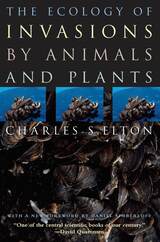 The Ecology of Invasions by Animals and Plants
Charles S. Elton
University of Chicago Press, 2000 A prescient, foundational work that David Quammen called "one of the central scientific books of our century"
Much as Rachel Carson's Silent Spring was a call to action against the pesticides that were devastating bird populations, Charles S. Elton's classic The Ecology of Invasions by Animals and Plants sounded an early warning about an environmental catastrophe that has become all too familiar today—the invasion of nonnative species. From kudzu to zebra mussels to Asian long-horned beetles, nonnative species are colonizing new habitats around the world at an alarming rate thanks to accidental and intentional human intervention. One of the leading causes of extinctions of native animals and plants, invasive species also wreak severe economic havoc, causing $79 billion worth of damage in the United States alone.
Elton explains the devastating effects that invasive species can have on local ecosystems in clear, concise language and with numerous examples. The first book on invasion biology, and still the most cited, Elton's masterpiece provides an accessible, engaging introduction to one of the most important environmental crises of our time.
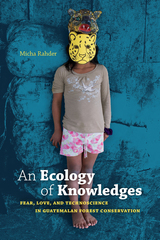 An Ecology of Knowledges: Fear, Love, and Technoscience in Guatemalan Forest Conservation
Micha Rahder
Duke University Press, 2020 Guatemala's Maya Biosphere Reserve (MBR), the largest protected area in Central America, is characterized by rampant violence, social and ethnic inequality, and rapid deforestation. Faced with these threats, local residents, conservationists, scientists, and NGOs in the region work within what Micha Rahder calls “an ecology of knowledges,” in which interventions on the MBR landscape are tied to differing and sometimes competing forms of knowing. In this book, Rahder examines how technoscience, endemic violence, and an embodied love of wild species and places shape conservation practices in Guatemala. Rahder highlights how different forms of environmental knowledge emerge from encounters and relations between humans and nonhumans, institutions and local actors, and how situated ways of knowing impact conservation practices and natural places, often in unexpected and unintended ways. In so doing, she opens up new ways of thinking about the complexities of environmental knowledge and conservation in the context of instability, inequality, and violence around the world.
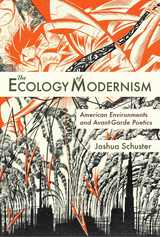 The Ecology of Modernism: American Environments and Avant-Garde Poetics
Joshua Schuster
University of Alabama Press, 2015 In The Ecology of Modernism, Joshua Schuster examines the relationships of key modernist writers, poets, and musicians to nature, industrial development, and pollution. He posits that the curious failure of modernist poets to develop an environmental ethic was a deliberate choice and not an inadvertent omission.
In his opening passage, Schuster boldly invokes lines from Walt Whitman’s “Crossing Brooklyn Ferry,” which echo as a paean to pollution: “Burn high your fires, foundry chimneys! cast black shadows at nightfall!” Schuster labels this theme “regeneration through pollution” and demonstrates how this motif recurs in modernist compositions. This tolerance for, if not actual exultation of, the by-products of industrialization hindered modernist American artists, writers, and musicians from embracing environmentalist agendas.
Schuster provides specific case studies focusing on Marianne Moore and her connection of fables with animal rights; Gertrude Stein and concepts of nature in her avant-garde poetics; early blues music and poetry and the issue of how environmental disasters (floods, droughts, pestilence) affected black farmers and artists in the American South; and John Cage, who extends the modernist avant-garde project formally but critiques it at the same time for failing to engage with ecology. A fascinating afterword about the role of oil in modernist literary production rounds out this work.
Schuster masterfully shines a light on the modernist interval between the writings of bucolic and nature-extolling Romantics and the emergence of a self-conscious green movement in the 1960s. This rewarding work shows that the reticence of modernist poets in the face of resource depletion, pollution, animal rights, and other ecological traumas is highly significant.
 The Ecology of Neotropical Savannas
Guillermo Sarmiento
Harvard University Press, 1984 Savanna ecosystems play a major role in the natural landscape and in the economic life of vast areas of the tropics. These grasslands are inherently fragile, yet Third World economic development makes human exploitation inevitable. The question that remains is whether utilization of the savannas for agriculture and other purposes will create sustained economic growth or a desert waste.
Guillermo Sarmiento is an unquestionable authority on the grasslands of the New World. His book is the first modern, integrated view of the genesis and function of this important natural system--a synthesis of savanna architecture, seasonal rhythms, productive processes, and water and nutrient economy. Sarmiento's emphasis is on the Venezuelan savannas that he has spent a lifetime studying, but his outlook is far broader. He makes frequent comparisons with other neotropical and tropical savannas and with temperate prairies, and he offers conclusions of global importance, not only for ecologists and agronomist but for anyone concerned with the politics of Third World development.
The Ecology of Others
Philippe Descola
Prickly Paradigm Press, 2013 Since the end of the nineteenth century, the division between nature and culture has been fundamental to Western thought. In this groundbreaking work, renowned anthropologist Philippe Descola seeks to break down this divide, arguing for a departure from the anthropocentric model and its rigid dualistic conception of nature and culture as distinct phenomena. In its stead, Descola proposes a radical new worldview, in which beings and objects, human and nonhuman, are understood through the complex relationships that they possess with one another. The Ecology of Others presents a compelling challenge to anthropologists, ecologists, and environmental studies scholars to rethink the way we conceive of humans, objects, and the environment. Thought-provoking and engagingly written, it will be required reading for all those interested in moving beyond the moving beyond the confines of this fascinating debate.
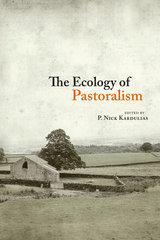 The Ecology of Pastoralism
P. Nick Kardulias
University Press of Colorado, 2015 In The Ecology of Pastoralism, diverse contributions from archaeologists and ethnographers address pastoralism’s significant impact on humanity’s basic subsistence and survival, focusing on the network of social, political, and religious institutions existing within various societies dependent on animal husbandry.
Pastoral peoples, both past and present, have organized their relationships with certain animals to maximize their ability to survive and adapt to a wide range of conditions over time. Contributors show that despite differences in landscape, environment, and administrative and political structures, these societies share a major characteristic—high flexibility. Based partially on the adaptability of various domestic animals to difficult environments and partially on the ability of people to establish networks allowing them to accommodate political, social, and economic needs, this flexibility is key to the survival of complex pastoral systems and serves as the connection among the varied cultures in the volume.
In The Ecology of Pastoralism, a variety of case studies from a broad geographic sampling uses archaeological and contemporary data and offers a new perspective on the study of pastoralism, making this volume a valuable contribution to current research in the area.
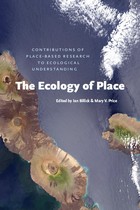 The Ecology of Place: Contributions of Place-Based Research to Ecological Understanding
Edited by Ian Billick and Mary V. Price
University of Chicago Press, 2010 Ecologists can spend a lifetime researching a small patch of the earth, studying the interactions between organisms and the environment, and exploring the roles those interactions play in determining distribution, abundance, and evolutionary change. With so few ecologists and so many systems to study, generalizations are essential. But how do you extrapolate knowledge about a well-studied area and apply it elsewhere?
Through a range of original essays written by eminent ecologists and naturalists, The Ecology of Place explores how place-focused research yields exportable general knowledge as well as practical local knowledge, and how society can facilitate ecological understanding by investing in field sites, place-centered databases, interdisciplinary collaborations, and field-oriented education programs that emphasize natural history. This unique patchwork of case-study narratives, philosophical musings, and historical analyses is tied together with commentaries from editors Ian Billick and Mary Price that develop and synthesize common threads. The result is a unique volume rich with all-too-rare insights into how science is actually done, as told by scientists themselves.
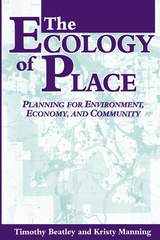 The Ecology of Place: Planning for Environment, Economy, and Community
Timothy Beatley and Kristy Manning
Island Press, 1997 Current patterns of land use and development are at once socially, economically, and environmentally destructive. Sprawling low-density development literally devours natural landscapes while breeding a pervasive sense of social isolation and exacerbating a vast array of economic problems. As more and more counties begin to look more and more the same, hope for a different future may seem to be fading. But alternatives do exist. The Ecology of Place, Timothy Beatley and Kristy Manning describe a world in which land is consumed sparingly, cities and towns are vibrant and green, local economies thrive, and citizens work together to create places of eduring value. They present a holistic and compelling approach to repairing and enhancing communities, introducing a vision of "sustainable places" that extends beyond traditional architecture and urban design to consider not just the physical layout of a development but the broad set of ways in which communities are organized and operate. Chapters examine: - the history and context of current land use problems, along with the concept of "sustainable places"
- the ecology of place and ecological policies and actions
- local and regional economic development
- links between land-use and community planning and civic involvement
- specific recommendations to help move toward sustainability
The authors address a variety of policy and development issues that affect a community -- from its economic base to its transit options to the ways in which its streets and public spaces are managed -- and examine the wide range of programs, policies, and creative ideas that can be used to turn the vision of sustainable places into reality. The Ecology of Place is a timely resource for planners, economic development specialists, students, and citizen activists working toward establishing healthier and more sustainable patterns of growth and development.
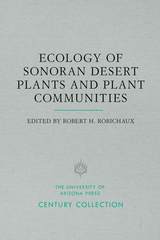 Ecology of Sonoran Desert Plants and Plant Communities
Edited by Robert H. Robichaux
University of Arizona Press, 1999 The Sonoran Desert is a distinctive biotic region that fascinates scientist, students, and nature lovers. This book offers an accessible introduction to Sonoran Desert ecology. Eight original essays by Sonoran Desert specialists such as Paul Martin and Richard Felger provide an overview of the practice of ecology at landscape, community, and organismal scales. The essays explore the rich diversity of plant life in the Sonoran Desert and the ecological patterns and processes that underlie it. They also reveal the history and scientific legacy of the Desert Laboratory in Tucson, which has conducted research on the Sonoran Desert since 1903. Coverage includes diversity and affinities of the flora, physical environments and vegetation, landscape complexity and ecological diversity, population dynamics of annual plants, form and function of cacti, and the relationship between plants and the animals that use them as feeding and breeding resources. The text also examines the ecological consequences of modern agricultural development, as well as the impact on the modern biota of 40,000 years of change in climate, vegetation, megafauna, and ancient cultures. This comprehensive book covers a broad range of spatial and temporal scales to highlight the diversity of research being pursued in the Sonoran Desert. It is both a testament to these ongoing studies and an authoritative introduction to the diverse plant life in the region. Contents
1. Diversity and Affinities of the Flora of the Sonoran Floristic Province, Steven P. McLaughlin and Janice E. Bowers
2. Vegetation and Habitat Diversity at the Southern Edge of the Sonoran Desert, Alberto Bórquez, Angelina Martínez Yrízar, Richard S. Felger, and David Yetman 3. The Sonoran Desert: Landscape Complexity and Ecological Diversity, Joseph R. McAuliffe
4. Population Ecology of Sonoran Desert Annual Plants, D. Lawrence Venable and Catherine E. Pake
5. Form and Function of Cacti, Park S. Nobel and Michael E. Loik
6. Ecological Genetics of Cactophilic Drosophila, William J. Etges, W. R. Johnson, G. A. Duncan, G. Huckins, and W. B. Heed
7. Ecological Consequences of Agricultural Development in a Sonoran Desert Valley, Laura L. Jackson and Patricia W. Comus
8. Deep History and a Wilder West, Paul S. Martin
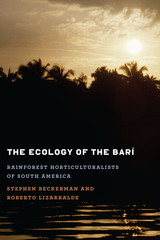 The Ecology of the Barí: Rainforest Horticulturalists of South America
By Stephen Beckerman and Roberto Lizarralde
University of Texas Press, 2013 Inhabiting the rainforest of the southwest Maracaibo Basin, split by the border between Colombia and Venezuela, the Barí have survived centuries of incursions. Anthropologist Roberto Lizarralde began studying the Barí in 1960, when he made the first modern peaceful contact with this previously unreceptive people; he was joined by anthropologist Stephen Beckerman in 1970. The Ecology of the Barí showcases the findings of their singular long-term study. Detailing the Barí’s relations with natural and social environments, this work presents quantitative subsistence data unmatched elsewhere in anthropological publications. The authors’ lengthy longitudinal fieldwork provided the rare opportunity to study a tribal people before, during, and after their aboriginal patterns of subsistence and reproduction were eroded by the modern world. Of particular interest is the book’s exploration of partible paternity—the widespread belief in lowland South America that a child can have more than one biological father. The study illustrates its quantitative findings with an in-depth biographical sketch of the remarkable life of an individual Barí woman and a history of Barí relations with outsiders, as well as a description of the rainforest environment that has informed all aspects of Barí history for the past five hundred years. Focusing on subsistence, defense, and reproduction, the chapters beautifully capture the Barí’s traditional culture and the loss represented by its substantial transformation over the past half-century.
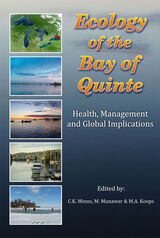 Ecology of the Bay of Quinte: Health, Management and Global Implications
C.K. Minns
Michigan State University Press, 2022 Project Quinte was a Canadian multi-agency collaborative initiative—launched in 1972 and lasting until 2018—that generated the longest ecosystem-based data set in the Great Lakes. The project produced a special bulletin of the Canadian Journal of Fisheries Science in 1986 and two special issues of Aquatic Ecosystem Health & Management more recently. This monograph provides a broad sweep of the many facets of aquatic ecosystem structure and function that were explored in efforts to define and solve the challenges to ecosystem health present in the Bay of Quinte ecosystem and to sustain it hopefully far into the future. Many papers provide a long-term perspective that highlights the need to maintain monitoring programs while increasing our basic knowledge. Long-term studies of ecosystems like Quinte continually reveal new questions and challenges beyond the scope of controlled laboratory experiments. The health of the Bay of Quinte is much improved as a result of the long-term participation of people, time, and resources reflected in this book. The monograph through its twenty-six in-depth chapters opens a wide panorama for exploration and application of the ecosystem approach and the resulting productivity, with much remaining to be done by those that follow in these footsteps. Approximately one hundred scientists have collectively participated toward the preparation of various chapters included in this meticulously peer-reviewed monograph.
Ecology of the Body: Styles of Behavior in Human Life
Joseph Lyons
Duke University Press, 1987 Ecology of the Body presents an argument for describing our behavior in accordance with the ways we experience our bodies. Increasingly, psychologists are recognizing that human beings show great diversity in the ways they perform the vast repertoire of human behaviors—such as perceiving, reasoning, remembering, forgetting—that we may well possess not simply different levels of "intelligence" but also different forms of it in varying combinations, just as we show differing degrees of emotion, goal-directed activity, and creativity. Lyons puts forward a hypothesis in which he argues for the utility of understanding these differences as stylistic variations that are inseparable from our physical experience of ourselves.
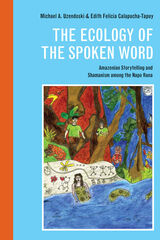 The Ecology of the Spoken Word: Amazonian Storytelling and the Shamanism among the Napo Runa
Michael A. Uzendoski and Edith Felicia Calapucha-Tapuy
University of Illinois Press, 2012 This volume offers the first theoretical and experiential translation of Napo Runa mythology in English. Michael A. Uzendoski and Edith Felicia Calapucha-Tapuy present and analyze lowland Quichua speakers in the Napo province of Ecuador through narratives, songs, curing chants, and other oral performances, so readers may come to understand and appreciate Quichua aesthetic expression. Guiding readers into Quichua ways of thinking and being--in which language itself is only a part of a communicative world that includes plants, animals, and the landscape--Uzendoski and Calapucha-Tapuy weave exacting translations into an interpretive argument with theoretical implications for understanding oral traditions, literacy, new technologies, and language. A companion websiteoffers photos, audio files, and videos of original performances illustrates the beauty and complexity of Amazonian Quichua poetic expressions.
 Ecology without Culture: Aesthetics for a Toxic World
Christine L. Marran
University of Minnesota Press, 2017 Cultures have long defined themselves through biological elements to prove their strength and longevity, from cherry blossoms in Japan to amber waves of grain in the United States. In Ecology without Culture, Christine L. Marran introduces the concept of biotropes—material and semiotic figures that exist for human perception—to navigate how and why the material world has proven to be such an effective medium for representing culture. A bold and timely reconsideration of ecocriticism, Ecology without Culture insists on decentering questions of culture to highlight the materiality of poetry, film, and prose fiction. Marran argues that ecocriticism can critique ecological realities more effectively from outside the frame of human exceptionalism. Through discussions of primarily non-Anglophone literature, poetry, and cinema about toxic events in contemporary history— from the depiction of slow violence in documentary by Tsuchimoto Noriaki to the powerful poetry of Ishimure Michiko—Marran argues that ecocriticism must find a way to engage culture without making the perpetuation of ethnos and anthropos the endgame of ecopolitics. Using the biological foundations and geological time scales of textual worlds to more deeply critique cultural humanism, Marran ultimately contends that the chief stumbling block to ecological thinking is not the image of nature, but the image of culture.
 Ecology without Nature: Rethinking Environmental Aesthetics
Timothy Morton
Harvard University Press, 2009 In Ecology without Nature, Timothy Morton argues that the chief stumbling block to environmental thinking is the image of nature itself. Ecological writers propose a new worldview, but their very zeal to preserve the natural world leads them away from the "nature" they revere. The problem is a symptom of the ecological catastrophe in which we are living. Morton sets out a seeming paradox: to have a properly ecological view, we must relinquish the idea of nature once and for all.
Ecology without Nature investigates our ecological assumptions in a way that is provocative and deeply engaging. Ranging widely in eighteenth-century through contemporary philosophy, culture, and history, he explores the value of art in imagining environmental projects for the future. Morton develops a fresh vocabulary for reading "environmentality" in artistic form as well as content, and traces the contexts of ecological constructs through the history of capitalism. From John Clare to John Cage, from Kierkegaard to Kristeva, from The Lord of the Rings to electronic life forms, Ecology without Nature widens our view of ecological criticism, and deepens our understanding of ecology itself. Instead of trying to use an idea of nature to heal what society has damaged, Morton sets out a radical new form of ecological criticism: "dark ecology."
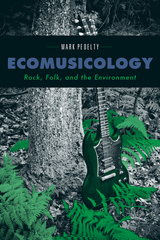 Ecomusicology: Rock, Folk, and the Environment
Mark Pedelty
Temple University Press, 2012 Can musicians really make the world more sustainable? Anthropologist Mark Pedelty, joined an eco-oriented band, the Hypoxic Punks, to find out. In his timely and exciting book, Ecomusicology, Pedelty explores the political ecology of rock, from local bands to global superstars. He examines the climate change controversies of U2's 360 Degrees stadium tour—deemed excessive by some—and the struggles of local folk singers who perform songs about the environment. In the process, he raises serious questions about the environmental effects and meanings on music.
Ecomusicology examines the global, national, regional, and historical contexts in which environmental pop is performed. Pedelty reveals the ecological potentials and pitfalls of contemporary popular music, in part through ethnographic fieldwork among performers, audiences, and activists. Ultimately, he explains how popular music dramatically reflects both the contradictions and dreams of communities searching for sustainability.
 Eco-Nationalism: Anti-Nuclear Activism and National Identity in Russia, Lithuania, and Ukraine
Jane I. Dawson
Duke University Press, 1996 Eco-nationalism examines the spectacular rise of the anti-nuclear power movement in the former Soviet Union during the early perestroika period, its unexpected successes in the late 1980s, and its substantial decline after 1991. Jane I. Dawson argues that anti-nuclear activism, one of the most dynamic social forces to emerge during these years, was primarily a surrogate for an ever-present nationalism and a means of demanding greater local self-determination under the Soviet system. Rather than representing strongly held environmental and anti-nuclear convictions, this activism was a political effort that reflected widely held anti-Soviet sentiments and a resentment against Moscow’s domination of the region—an effort that largely disappeared with the dissolution of the USSR.
Dawson combines a theoretical framework based on models of social movements with extensive field research to compare the ways in which nationalism, regionalism, and other political demands were incorporated into anti-nuclear movements in Russia, Lithuania, Ukraine, Armenia, Tatarstan, and Crimea. These comparative case studies form the core of the book and trace differences among the various regional movements to the distinctive national identities of groups involved. Reflecting the new opportunities for research that have become available since the late 1980s, these studies draw upon Dawson’s extended on-site observation of local movements through 1995 and her unique access to movement activists and their personal archives.
Analyzing and documenting a development with sobering and potentially devastating implications for nuclear power safety in the former USSR and beyond, Eco-nationalism’s examination of social activism in late and postcommunist societies will interest readers concerned with the politics of global environmentalism and the process of democratization in the post-Soviet world.
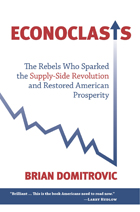 Econoclasts: The Rebels Who Sparked the Supply-Side Revolution and Restored American Prosperity
Brian Domitrovic
Intercollegiate Studies Institute, 2009
“Brilliant . . . This is the book Americans need to read now.”—Larry Kudlow
“Should be required reading.” —Weekly Standard
“An amazing history of one of the most important chapters in the evolution of economic thought. . . . Will someone please deliver this book to [President Obama’s] doorstep?” —Claremont Review of Books
“A brilliant, overlooked book.” —Peter Ferrara, American Spectator
“Couldn’t be more timely.” —Amity Shlaes
“I’ve never read anything on the subject of economics that surpasses this extraordinary book for its lucidity, richness, depth, intelligibility, savvy, and sheer intellectual excitement.” —Wilfred McClay
The history we can’t afford to forget
At last, the definitive history of supply-side economics—an incredibly timely work that reveals the foundations of America’s prosperity when those very foundations are under attack.
In the riveting, groundbreaking book Econoclasts, historian Brian Domitrovic tells the remarkable story of the economists, journalists, Washington staffers, and (ultimately) politicians who showed America how to get out of the 1970s stagflation and ushered in an unprecedented quarter-century run of growth and opportunity.
Based on the author’s years of archival research, Econoclasts is a masterful narrative history in the tradition of Amity Shlaes’s The Forgotten Man and John Steele Gordon’s An Empire of Wealth.
An Econometric Model of Canada under the Fluctuating Exchange Rate
Lawrence H. Officer
Harvard University Press Between September 30, 1950, and May 2, 1962, the value of the Canadian dollar was allowed to fluctuate. This situation, in conjunction with an abundance of Canadian quantitative data, provided Lawrence Officer with a unique opportunity to test theories concerning an economy under the influence of a fluctuating exchange rate. In order to explain the fluctuations that occurred, Mr. Officer set up a model of Canada's economy for the relevant time period. In contrast to conventional models, the exchange rate is the key variable in the system and the foreign sector receives particular attention because of its primary role in determining the exchange rate.
 Economic & Social Origins of Mau Mau, 1945–1953: Eastern African Studies
David Throup
Ohio University Press, 1990 This story of Kenya in the decade before the outbreak of the Mau Mau emergency presents an integrated view of imperial government as well as examining the social and economic causes of the Kikuyu revolt. Dr. Throup combines traditional Imperial History with its emphasis on the high politics of “The Official Mind” in the Colonial Office or in Government House with the new African historiography that concentrates on the people themselves. Sir Philip Mitchell was the proconsul chosen to reassert metropolitan authority. Under Kenyatta’s leadership the Kenya African Union mobilized a popular constituency among the peasantry. In Nairobi the Kikuyu street gangs linked up with the militant Kikuyu trade unions, led by Fred Kubai and Bildad Kaggia, to challenge Kenyatta’s leadership. The Mau Mau movement, as it was called by the government, was an alliance between three groups of discontented Kikuyu: the urban unemployed and destitute, the dispossessed squatters from the White Highlands and the tenants and members of the junior clans in the Kikuyu reserves. The revolt was a dominating factor in convincing the conservative imperial government that the cost of repression in the African colonies was not worth the troops and resources.
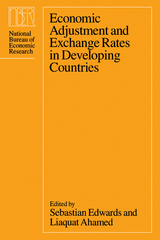 Economic Adjustment and Exchange Rates in Developing Countries
Edited by Sebastian Edwards and Liaquat Ahamed
University of Chicago Press, 1986 In spite of the attention paid exchange rates in recent economic debates on developing countries, relatively few studies have systematically analyzed in detail the various ramifications of exchange rate policy in these countries. In this new volume from the National Bureau of Economic Research, leading economists use rigorous models to tackle various exchange rate issues, while also illuminating policy implications that emerge from their analyses.
The volume, divided into four main sections, addresses: the role of exchange rates in stabilization programs and the adjustment process; the importance of exchange rate policy during liberalization reform in developing countries; exchange rate problems relevant and unique to developing countries, illustrated by case studies; and the problems defining, measuring, and identifying determinants of real exchange rates. Authors of individual papers examine the relation between commercial policies and exchange rates, the role of exchange rate policy in stabilization programs, the effectiveness of devaluations as a policy tool, and the interaction between exchange rate terms of trade an capital flow. This research will not only prove crucial to our understanding of the role of exchange rates in developing countries, but will clearly set the standard for future work in the field.
 Economic Adjustment and Reform in Eastern Europe and the Soviet Union: Essays in Honor of Franklyn D. Holzman
Josef C. Brada, Ed A. Hewett, and Thomas Wolf, eds.
Duke University Press, 1988 Economic reform, structural adjustment, macroeconomic stabilization, and participation in the world economy are interconnected aspects of the same issue: the long-term economic viability of centrally planned economies in the rapidly changing economic environment of the modern world. Any economic strategy that focuses on only one or two of these aspects at the expense of the others is likely to fail; yet even strategies that build on all of these bases may well fail unless political leaders can muster exceptional skill, garner international support, and enjoy some good luck. The contributions to this volume reflect the recent research on this issue by various specialists on the economies of the Soviet Union and Eastern Europe. Each author emphasizes macroeconomic stabilization, structural adjustment, participation in the larger world economy, or ecomonic reform.
 Economic Analysis and Infrastructure Investment
Edited by Edward L. Glaeser and James M. Poterba
University of Chicago Press, 2021 Policy makers often call for increased spending on infrastructure, which can encompass a broad range of investments, from roads and bridges to digital networks that will expand access to high-speed broadband. Some point to the near-term macroeconomic benefits, such as job creation, associated with infrastructure spending; others point to the long-term effects of such spending on productivity and economic growth.
Economic Analysis and Infrastructure Investment explores the links between infrastructure investment and economic outcomes, analyzing key economic issues in the funding and management of infrastructure projects. It includes new research on the short-run stimulus effects of infrastructure spending, develops new estimates of the stock of US infrastructure capital, and explores incentive aspects of public-private partnerships with particular attention to their allocation of risk. The volume provides a reference for researchers seeking to study infrastructure issues and for policymakers tasked with determining the appropriate level and allocation of infrastructure spending.
 Economic Analysis of Accident Law
Steven Shavell
Harvard University Press, 1987 “[This] is certainly a masterpiece.”—Thomas S. Ulen, Journal of Economic Literature
“The strength of Shavell’s book is its lucid, structured development and explication of the economic model. It represents the best systematic presentation of the relevance of economic argument for issues of risk allocation.”—Jules L. Coleman, Yale Law Journal
“Steven Shavell…[has] drawn upon [his] previous path-breaking work to issue [one of] the most important books in the law and economics of tort law since the release in 1970 of Guido Calabresi’s The Costs of Accidents…The work is a masterful tribute to the power of economic modelling and the use of optimization techniques…I, for one, was immensely impressed by the richness of the insights that Shavell’s theoretical approach provided into the fundamental issues of tort law.”—John J. Donohue III, Harvard Law Review
Accident law, if properly designed, is capable of reducing the incidence of mishaps by making people act more cautiously. Scholarly writing on this branch of law traditionally has been concerned with examining the law for consistency with felt notions of right and duty. Since the 1960s, however, a group of legal scholars and economists have focused on identifying the effects of accident law on people’s behavior. Steven Shavell’s book is the definitive synthesis of research to date in this new field.
 Economic Analysis of Product Innovation: The Case of CT Scanners
Manuel Trajtenberg
Harvard University Press, 1990 One of the most striking features of contemporary industrial economies is their ability to offer an ever-expanding and improving range of products. Personal computers, tiny pacemakers, digital watches, and VCRs simply did not exist, and were not even dreamt of, only a few decades ago. Such product innovations play an increasingly important role in modern economic growth, and it is therefore imperative that economists come to grips with them, just as they have done with traditional economic phenomena.
In this skillfully crafted and imaginative study, Manuel Trajtenberg develops the tools to quantify and analyze the notion of product innovation. He argues persuasively that the magnitude of an innovation should be equated with the social benefits that it generates. Drawing from the "characteristics approach" to demand theory and the econometrics of discrete choice, he presents an ingenious method to estimate the benefits from product innovations that accrue to the consumer over time. His method centers on consumer preferences for different product attributes -such as speed and size of memory in computers-and then uses those preferences to evaluate the changes in attributes.
Trajtenberg applies his approach to the study of one of the most remarkable innovations in medical technology--Computed Tomography (CT) scanners. He assembled for that purpose an impressive set of data on every aspect of the new technology, from qualities and prices, patents and research, to details on virtually every sale in the United States during the decade following the introduction of CT in 1973. This close-up view of an innovation, quite rare in economic literature, offers valuable insights on the nature of the innovative process, the interaction between innovation and diffusion, the effects of uncertainty about quality, and the implications of changing preferences.
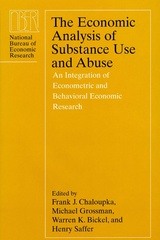 The Economic Analysis of Substance Use and Abuse: An Integration of Econometric and Behavioral Economic Research
Edited by Frank J. Chaloupka, Michael Grossman, Warren K. Bickel, and Henry Saffer
University of Chicago Press, 1999 Conventional wisdom once held that the demand for addictive substances like cigarettes, alcohol, and drugs was unlike that for any other economic good and, therefore, unresponsive to traditional market forces. Recently, however, researchers from two disparate fields, economics and behavioral psychology, have found that increases in the overall price of an addictive substance can significantly reduce both the number of users and the amounts those users consume. Changes in the "full price" of addictive substances—including monetary value, time outlay, effort to obtain, and potential penalties for illegal use—yield marked variations in behavioral outcomes and demand.
The Economic Analysis of Substance Use and Abuse brings these distinctive fields of study together and presents for the first time an integrated assessment of their data and results. Unique and innovative, this multidisciplinary volume will serve as an important resource in the current debates concerning alcohol and drug use and abuse and the impacts of legalizing illicit drugs.
 Economic Analysis of the Digital Economy
Edited by Avi Goldfarb, Shane M. Greenstein, and Catherine E. Tucker
University of Chicago Press, 2015 As the cost of storing, sharing, and analyzing data has decreased, economic activity has become increasingly digital. But while the effects of digital technology and improved digital communication have been explored in a variety of contexts, the impact on economic activity—from consumer and entrepreneurial behavior to the ways in which governments determine policy—is less well understood.
Economic Analysis of the Digital Economy explores the economic impact of digitization, with each chapter identifying a promising new area of research. The Internet is one of the key drivers of growth in digital communication, and the first set of chapters discusses basic supply-and-demand factors related to access. Later chapters discuss new opportunities and challenges created by digital technology and describe some of the most pressing policy issues. As digital technologies continue to gain in momentum and importance, it has become clear that digitization has features that do not fit well into traditional economic models. This suggests a need for a better understanding of the impact of digital technology on economic activity, and Economic Analysis of the Digital Economy brings together leading scholars to explore this emerging area of research.
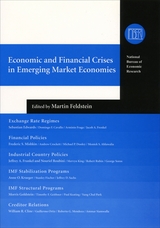 Economic and Financial Crises in Emerging Market Economies
Edited by Martin Feldstein
University of Chicago Press, 2003 In the late 1990s, economic and financial crises raged through East Asia, devastating economies that had previously been considered among the strongest in the developing world. The crises eventually spread to Russia, Turkey, and Latin America, and impacted the economies of many industrialized nations as well. In today's increasingly interdependent world, finding ways to reduce the risk of future crises—and to improve the management of crises when they occur—has become an international policy challenge of paramount importance.
This book rises to that challenge, presenting accessible papers and commentaries on the topic not only from leading academic economists, but also from high-ranking government officials (in both industrial and developing nations), senior policymakers at international institutions, and major financial investors. Six non-technical papers, each written by a specialist in the topic, provide essential economic background, introducing sections on exchange rate regimes, financial policies, industrial country policies, IMF stabilization policies, IMF structural programs, and creditor relations. Next, personal statements from the major players give firsthand accounts of what really went on behind the scenes during the crises, giving us a rare glimpse into how international economic policy decisions are actually made. Finally, wide-ranging discussions and debates sparked by these papers and statements are summarized at the end of each section.
The result is an indispensable overview of the key issues at work in these crises, written by the people who move markets and reshape economies, and accessible to not just economists and policymakers, but also to educated general readers.
Contributors:
Montek S. Ahluwalia, Domingo F. Cavallo, William R. Cline, Andrew Crockett, Michael P. Dooley, Sebastian Edwards, Stanley Fischer, Arminio Fraga, Jeffrey Frankel, Jacob Frenkel, Timothy F. Geithner, Morris Goldstein, Paul Keating, Mervyn King, Anne O. Krueger, Roberto Mendoza, Frederic S. Mishkin, Guillermo Ortiz, Yung Chul Park, Nouriel Roubini, Robert Rubin, Jeffrey Sachs, Ammar Siamwalla, George Soros
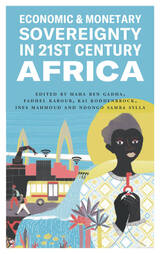 Economic and Monetary Sovereignty in 21st Century Africa
Maha Ben Gadha
Pluto Press, 2021 Over forty years after the formal end of colonialism, suffocating ties to Western financial systems continue to prevent African countries from achieving any meaningful monetary sovereignty.
Economic and Monetary Sovereignty in 21st Century Africa traces the recent history of African monetary and financial dependencies, looking at the ways African nations are resisting colonial legacies. Using a comparative, multi-disciplinary approach, this book uncovers what went wrong after the Pan-African approaches that defined the early stages of independence, and how most African economies fell into the firm grip of the IMF, World Bank, and the EU’s strict neoliberal policies.
This collection is the first to offer a wide-ranging, comparative and historical look at how African societies have attempted to increase their policy influence and move beyond neoliberal orthodoxy and US-dollar dependency. Economic and Monetary Sovereignty in 21st Century Africa is essential reading for anyone interested in the African quest for self-determination in a turbulent world of recurring economic and financial crises.
Economic and Political Development: A Theoretical Approach and a Brazilian Case Study
Helio Jaguaribe
Harvard University Press This original and enlightening exploration of economic and political development, by one of Latin America's most distinguished political scientists, was originally published in Brazil in 1962 and has now been translated into English by the author. Helio Jaguaribe offers first a theoretical discussion of the political requirements of economic development, emphasizing that sound government programs must be based upon a thorough understanding of a country's existing social and political structures. The author then provides a detailed, analytical study of the development process in Brazil from the colonial phase until today, and a comparison of the Brazilian experience with those of other Latin American countries.
Economic and Social Organization of a Complex Chiefdom: The Halelea District, Kaua’i, Hawaii
Timothy Earle
University of Michigan Press, 1978 In the early 1970s, Timothy Earle worked with Marshall Sahlins doing archaeological and ethnohistorical research on the Halelea district in Kaua’i, Hawaii. In this volume, Earle reports on his archaeological and historical research on irrigation in this region. He also discusses modern taro agriculture and community organization. Illustrations by Eliza H. Earle.
Economic and Societal Impacts of Tornadoes
Kevin M. Simmons and Daniel Sutter
American Meteorological Society, 2011 For almost a decade, economists Kevin M. Simmons and Daniel Sutter have been studying the economic impacts and social consequences of the approximately 1,200 tornadoes that touch down across the United States annually. During this time, Simmons and Sutter have been compiling information from sources such as the National Oceanic and Atmospheric Administration and the U.S. Census in order to examine the casualties caused by tornadoes and to evaluate the National Weather Service’s efforts to reduce these casualties. In Economic and Societal Impacts of Tornadoes, Simmons and Sutter present their findings. This analysis will be extremely useful to anyone studying meteorology and imperative for anyone working in emergency disaster management.
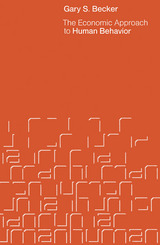 The Economic Approach to Human Behavior
Gary S. Becker
University of Chicago Press, 1976 Since his pioneering application of economic analysis to racial discrimination, Gary S. Becker has shown that an economic approach can provide a unified framework for understanding all human behavior. In a highly readable selection of essays Becker applies this approach to various aspects of human activity, including social interactions; crime and punishment; marriage, fertility, and the family; and "irrational" behavior.
"Becker's highly regarded work in economics is most notable in the imaginative application of 'the economic approach' to a surprising breadth of human activity. Becker's essays over the years have inevitably inspired a surge of research activity in testimony to the richness of his insights into human activities lying 'outside' the traditionally conceived economic markets. Perhaps no economist in our time has contributed more to expanding the area of interest to economists than Becker, and a number of these thought-provoking essays are collected in this book."—Choice
Gary Becker was awarded the Nobel Prize in Economic Science in 1992.
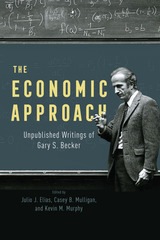 The Economic Approach: Unpublished Writings of Gary S. Becker
Gary S. Becker
University of Chicago Press, 2023 Now in paperback, a revealing collection from the intellectual titan whose work shaped the modern world. As an economist and public intellectual, Gary S. Becker was a giant. The recipient of a Nobel Prize, a John Bates Clark Medal, and a Presidential Medal of Freedom, Becker is widely regarded as the greatest microeconomist in history. After forty years at the University of Chicago, Becker left a slew of unpublished writings that used an economic approach to human behavior, analyzing such topics as preference formation, rational indoctrination, income inequality, drugs and addiction, and the economics of family. These papers unveil the process and personality—direct, critical, curious—that made him a beloved figure in his field and beyond. The Economic Approach examines these extant works as a capstone to the Becker oeuvre—not because the works are perfect, but because they offer an illuminating, instructive glimpse into the machinations of an economist who wasn’t motivated by publications. Here, and throughout his works, an inquisitive spirit remains remarkable and forever resonant.
Economic Aspects of Health
Edited by Victor R. Fuchs
University of Chicago Press, 1982 Unlike earlier work in medical economics, which has focused on medical care, these ten papers stress the production and consequences of health itself. They reveal a serious concern with real-world health problems in their investigation of such subjects as infant mortality, life expectancy, morbidity, and disability. These papers are unusual, as well, in bringing to bear on these problems new and powerful theoretical and statistical tools. They draw on, and in some cases are, original sources for new bodies of data. As such, Economic Aspects of Health comprises a useful blend of relevance and rigor.
Economic Aspects of Obesity
Edited by Michael Grossman and Naci Mocan
University of Chicago Press, 2011 In the past three decades, the number of obese adults in the United States has doubled and the number of obese children almost tripled, which may lead to increased medical expenditures, productivity loss, and stress on the health care system. Economic analysis now shows that weight gain is the result of individual choices in response to economic environments and demonstrates that incentives can influence individual behaviors affecting weight. Determinants are varied and include year- and area-specific food prices, availability of food outlets and recreational facilities, health insurance, and minimum wage levels. Timely and important, Economic Aspects of Obesity provides a strong foundation for evaluating the costs and benefits of various proposals designed to control obesity rates.
 Economic Backwardness in Historical Perspective
Alexander Gerschenkron
Harvard University Press These fourteen essays covering a wide range of subjects of great current interest reflect the continuous evolution of the author’s thought from 1951 to 1961. Range and flexibility characterize Alexander Gerschenkron’s dynamic approach to Europe’s industrial history. Connecting evolution in individual countries with their degree of economic backwardness, he presents the industrialization of the continent as a “case of unity in diversity,” thus offering a cogent alternative, supported by case studies, to the traditional view of industrialization as monotonous repetition of the same process from country to country. Brought together for the first time, these essays were originally published in specialized periodicals in the United States and abroad.
Explaining and systematizing the elements of creative innovation in industrial history, Gerschenkron opens new paths of research and poses a number of pertinent questions for the problem of economic development in backward countries. His versatile analysis not only includes construction of ingenious industrial output indices and fruitful historical hypotheses on the index-number problem, but also original insights gleaned from a study of Soviet novels and a brilliant critique of Doctor Zhivago.
 Economic Behaviour in Adversity
Jack Hirshleifer
University of Chicago Press, 1988 Conflict, disaster, and destruction—despite their historical and current significance—have not yet been adequately studied from the economic point of view. Economic Behaviour in Adversity brings together ten important essays, several previously unpublished, dealing with the choices people make in times of disaster and conflict. These essays help explain the possibilities and limits of human cooperation under severe environmental pressure.
Part I, "Disaster and Recovery," contains previously unpublished studies of major historical catastrophes, among them the Black Death of the fourteenth century, the Civil War in Russia that followed the Bolshevik revolution, and the mass bombing of Germany and of Japan during World War II. Accompanying the historical studies are several analytical papers that interpret the disaster experience.
The essays in Part II, "Cooperation and Conflict," represent innovative theoretical analyses based on a common theme—that cooperation and conflict are alternative strategies whereby individuals, groups, and different forms of social organization struggle with one another for evolutionary survival. Ultimately, these essays indicate, the political economy of the human species is an instance of Darwin's "economy of nature."
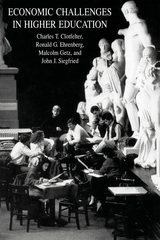 Economic Challenges in Higher Education
Charles T. Clotfelter, Ronald G. Ehrenberg, Malcolm Getz, and John J. Siegfried
University of Chicago Press, 1991 The last two decades have been a turbulent period for American higher education, with profound demographic shifts, gyrating salaries, and marked changes in the economy. While enrollments rose about 50% in that period, sharp increases in tuition and fees at colleges and universities provoke accusations of inefficiency, even outright institutional greed and irresponsibility. As the 1990s progress, surpluses in the academic labor supply may give way to shortages in many fields, but will there be enough new Ph.D.'s to go around?
Drawing on the authors' experience as economists and educators, this book offers an accessible analysis of three crucial economic issues: the growth and composition of undergraduate enrollments, the supply of faculty in the academic labor market, and the cost of operating colleges and universities. The study provides valuable insights for administrators and scholars of education.
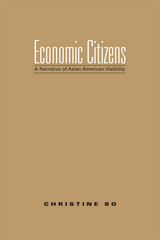 Economic Citizens: A Narrative of Asian American Visibility
Christine So
Temple University Press, 2009 In the past fifty years, according to Christine So, the narratives of many popular Asian American books have been dominated by economic questions-what money can buy, how money is lost, how money is circulated, and what labor or objects are worth. Focusing on books that have achieved mainstream popularity, Economic Citizens unveils the logic of economic exchange that determined Asian Americans’ transnational migrations and national belonging. With penetrating insight, So examines literary works that have been successful in the U.S. marketplace but have been read previously by critics largely as narratives of alienation or assimilation, including Fifth Chinese Daughter, Flower Drum Song, Falling Leaves and Turning Japanese. In contrast to other studies that have focused on the marginalization of Asian Americans, Economic Citizens examines how Asian Americans have entered into the public sphere.
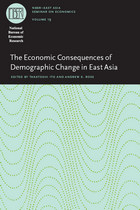 The Economic Consequences of Demographic Change in East Asia
Edited by Takatoshi Ito and Andrew K. Rose
University of Chicago Press, 2010 Recent studies show that almost all industrial countries have experienced dramatic decreases in both fertility and mortality rates. This situation has led to aging societies with economies that suffer from both a decline in the working population and a rise in fiscal deficits linked to increased government spending. East Asia exemplifies these trends, and this volume offers an in-depth look at how long-term demographic transitions have taken shape there and how they have affected the economy in the region.
The Economic Consequences of Demographic Change in East Asia assembles a group of experts to explore such topics as comparative demographic change, population aging, the rising cost of health care, and specific policy concerns in individual countries. The volume provides an overview of economic growth in East Asia as well as more specific studies on Japan, Korea, China, and Hong Kong. Offering important insights into the causes and consequences of this transition, this book will benefit students, researchers, and policy makers focused on East Asia as well as anyone concerned with similar trends elsewhere in the world.
Economic Decline and Political Change: Canada, Great Britain, the United States
Harold D. Clarke
University of Pittsburgh Press, 1989
In the 1970's, an “age of affluence” ended abruptly in Canada, Great Britain, and the United States. Skyrocketing inflation, persistent unemployment, and sluggish growth became new, oppressive realities for government and citizens alike. This book examines the changes that occurred in economic policymaking on the governmental level and the public's response to such changes. This timely collection of essays sheds light on the political economy of three of the world's oldest democracies in an era of economic distress and uncertainty.
Economic Development and Cultural Change, volume 71 number 2 (January 2023)
The University of Chicago Press
University of Chicago Press Journals, 2023 This is volume 71 issue 2 of Economic Development and Cultural Change. Economic Development and Cultural Change (EDCC) publishes studies that use modern theoretical and empirical approaches to examine both the determinants and the effects of various dimensions of economic development and cultural change. EDCC’s focus is on empirical papers with analytic underpinnings, concentrating on microlevel evidence, that use appropriate data to test theoretical models and explore policy impacts related to economic development.
Economic Development and Cultural Change, volume 71 number 3 (April 2023)
The University of Chicago Press
University of Chicago Press Journals, 2023 This is volume 71 issue 3 of Economic Development and Cultural Change. Economic Development and Cultural Change (EDCC) publishes studies that use modern theoretical and empirical approaches to examine both the determinants and the effects of various dimensions of economic development and cultural change. EDCC’s focus is on empirical papers with analytic underpinnings, concentrating on microlevel evidence, that use appropriate data to test theoretical models and explore policy impacts related to economic development.
Economic Development and Cultural Change, volume 71 number 4 (July 2023)
The University of Chicago Press
University of Chicago Press Journals, 2023 This is volume 71 issue 4 of Economic Development and Cultural Change. Economic Development and Cultural Change (EDCC) publishes studies that use modern theoretical and empirical approaches to examine both the determinants and the effects of various dimensions of economic development and cultural change. EDCC’s focus is on empirical papers with analytic underpinnings, concentrating on microlevel evidence, that use appropriate data to test theoretical models and explore policy impacts related to economic development.
Economic Development and Cultural Change, volume 72 number 1 (October 2023)
The University of Chicago Press
University of Chicago Press Journals, 2023 This is volume 72 issue 1 of Economic Development and Cultural Change. Economic Development and Cultural Change (EDCC) publishes studies that use modern theoretical and empirical approaches to examine both the determinants and the effects of various dimensions of economic development and cultural change. EDCC’s focus is on empirical papers with analytic underpinnings, concentrating on microlevel evidence, that use appropriate data to test theoretical models and explore policy impacts related to economic development.
Economic Development and Cultural Change, volume 72 number 2 (January 2024)
The University of Chicago Press
University of Chicago Press Journals, 2024 This is volume 72 issue 2 of Economic Development and Cultural Change. Economic Development and Cultural Change (EDCC) publishes studies that use modern theoretical and empirical approaches to examine both the determinants and the effects of various dimensions of economic development and cultural change. EDCC’s focus is on empirical papers with analytic underpinnings, concentrating on microlevel evidence, that use appropriate data to test theoretical models and explore policy impacts related to economic development.
Economic Development and Cultural Change, volume 72 number 3 (April 2024)
The University of Chicago Press
University of Chicago Press Journals, 2024 This is volume 72 issue 3 of Economic Development and Cultural Change. Economic Development and Cultural Change (EDCC) publishes studies that use modern theoretical and empirical approaches to examine both the determinants and the effects of various dimensions of economic development and cultural change. EDCC’s focus is on empirical papers with analytic underpinnings, concentrating on microlevel evidence, that use appropriate data to test theoretical models and explore policy impacts related to economic development.
Economic Development and Cultural Change, volume 72 number 4 (July 2024)
The University of Chicago Press
University of Chicago Press Journals, 2024 This is volume 72 issue 4 of Economic Development and Cultural Change. Economic Development and Cultural Change (EDCC) publishes studies that use modern theoretical and empirical approaches to examine both the determinants and the effects of various dimensions of economic development and cultural change. EDCC’s focus is on empirical papers with analytic underpinnings, concentrating on microlevel evidence, that use appropriate data to test theoretical models and explore policy impacts related to economic development.
Economic Development and Cultural Change, volume 73 number 1 (October 2024)
The University of Chicago Press
University of Chicago Press Journals, 2024 This is volume 73 issue 1 of Economic Development and Cultural Change. Economic Development and Cultural Change (EDCC) publishes studies that use modern theoretical and empirical approaches to examine both the determinants and the effects of various dimensions of economic development and cultural change. EDCC’s focus is on empirical papers with analytic underpinnings, concentrating on microlevel evidence, that use appropriate data to test theoretical models and explore policy impacts related to economic development.
Economic Development and Cultural Change, volume 73 number 2 (January 2025)
The University of Chicago Press
University of Chicago Press Journals, 2025 This is volume 73 issue 2 of Economic Development and Cultural Change. Economic Development and Cultural Change (EDCC) publishes studies that use modern theoretical and empirical approaches to examine both the determinants and the effects of various dimensions of economic development and cultural change. EDCC’s focus is on empirical papers with analytic underpinnings, concentrating on microlevel evidence, that use appropriate data to test theoretical models and explore policy impacts related to economic development.
Economic Development and Cultural Change, volume 73 number 3 (April 2025)
The University of Chicago Press
University of Chicago Press Journals, 2025 This is volume 73 issue 3 of Economic Development and Cultural Change. Economic Development and Cultural Change (EDCC) publishes studies that use modern theoretical and empirical approaches to examine both the determinants and the effects of various dimensions of economic development and cultural change. EDCC’s focus is on empirical papers with analytic underpinnings, concentrating on microlevel evidence, that use appropriate data to test theoretical models and explore policy impacts related to economic development.
Economic Development and Cultural Change, volume 73 number 4 (July 2025)
The University of Chicago Press
University of Chicago Press Journals, 2025 This is volume 73 issue 4 of Economic Development and Cultural Change. Economic Development and Cultural Change (EDCC) publishes studies that use modern theoretical and empirical approaches to examine both the determinants and the effects of various dimensions of economic development and cultural change. EDCC’s focus is on empirical papers with analytic underpinnings, concentrating on microlevel evidence, that use appropriate data to test theoretical models and explore policy impacts related to economic development.
Economic Development and Cultural Change, volume 74 number 1 (October 2025)
The University of Chicago Press
University of Chicago Press Journals, 2025 This is volume 74 issue 1 of Economic Development and Cultural Change. Economic Development and Cultural Change (EDCC) publishes studies that use modern theoretical and empirical approaches to examine both the determinants and the effects of various dimensions of economic development and cultural change. EDCC’s focus is on empirical papers with analytic underpinnings, concentrating on microlevel evidence, that use appropriate data to test theoretical models and explore policy impacts related to economic development.
Economic Development in Central America
Benjamin Alvarez, Gerardo Esquivel, Cristina Garcia Lopez, Mauricio Jenkins, Luis F. Lopez-Calva, Andrés Rodríguez-Clare, Jeffrey D. Sachs, and Jose Tavares; edited by Felipe Larraín B
Harvard University Press, 2001 For decades, Central America has faced market dependency, natural disasters, and political systems characterized by protectionist policies and low participation--situations that have had a tremendous impact on its economic development.
This two-volume set is a comprehensive assessment of Central America's position in the world economy, and it serves as a handbook for the important economic reforms Central America must undertake to become a viable competitor in the international economy.
Economic Development in Central America
Felipe Larraín B
Harvard University Press, 2001 For decades, Central America has faced market dependency, natural disasters, and political systems characterized by protectionist policies and low participation--situations that have had a tremendous impact on its economic development.
This two-volume set is a comprehensive assessment of Central America's position in the world economy, and it serves as a handbook for the important economic reforms Central America must undertake to become a viable competitor in the international economy.
The Economic Development of Manchuria: The Rise of a Frontier Economy
Kang Chao
University of Michigan Press, 1983 The economic development of Manchuria holds special fascination, since within the compass of a limited area and a self-contained time span of about one hundred years—between 1860 and 1960—we witness three different types of development patterns, based on three alternative sources of economic growth. The first and longest period, extending roughly from 1860 to 1930, was based on the development of an open frontier, the settlement of a new region. Application of the staple theory of growth to Manchurian conditions can help to illuminate the character of the growth process during this first period. In this connection the Manchurian development case invites comparison with growth processes in other newly settled regions, for example, the US, Canada, and Australia. [1]
Economic Development, Population Policy, and Demographic Transition in the Republic of Korea
Robert Repetto, Tae Hwan Kwon, Son-Ung Kim, Dae Young Kim, and Peter J. Donaldson
Harvard University Press, 1981 This latest volume in the series Studies in Modernization of the Republic of Korea: 1945-1975 examines the relationship between economic developments and the government’s population policy and its implementation. Against the background of Korea’s traditional population pattern and the baby boom of the 1950s, the authors consider the changes wrought by migration, fertility, decline, and the government’s evolving program for family planning. The change from a traditional agricultural economy with a high and largely unregulated birth rate to a predominantly urbanized economy with a widespread and sophisticated family-planning program is one further feature in the rapid modernization of Korean government and lifestyle since that country’s emergence from colonialism.
Economic Development: The History of an Idea
H. W. Arndt
University of Chicago Press, 1989 "Economic Development makes an important contribution of the literature on economic development, especially as it incorporates ideas on a theme that informs our concern for social justice, individual and social freedom, identify, and community."—Winston E. Langley, Annals of the American Academy of Political and Social Science
 Economic Dimensions of Personalized and Precision Medicine
Edited by Ernst R. Berndt, Dana P. Goldman, and John Rowe
University of Chicago Press, 2019 Personalized and precision medicine (PPM)—the targeting of therapies according to an individual’s genetic, environmental, or lifestyle characteristics—is becoming an increasingly important approach in health care treatment and prevention. The advancement of PPM is a challenge in traditional clinical, reimbursement, and regulatory landscapes because it is costly to develop and introduces a wide range of scientific, clinical, ethical, and socioeconomic issues. PPM raises a multitude of economic issues, including how information on accurate diagnosis and treatment success will be disseminated and who will bear the cost; changes to physician training to incorporate genetics, probability and statistics, and economic considerations; questions about whether the benefits of PPM will be confined to developed countries or will diffuse to emerging economies with less developed health care systems; the effects of patient heterogeneity on cost-effectiveness analysis; and opportunities for PPM’s growth beyond treatment of acute illness, such as prevention and reversal of chronic conditions.
This volume explores the intersection of the scientific, clinical, and economic factors affecting the development of PPM, including its effects on the drug pipeline, on reimbursement of PPM diagnostics and treatments, and on funding of the requisite underlying research; and it examines recent empirical applications of PPM.
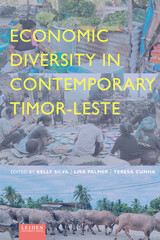 Economic Diversity in Contemporary Timor-Leste
Kelly Silva
Leiden University Press, 2023 Economic Diversity in Contemporary Timor-Leste analyses various economic dynamics in past and present Timor-Leste. Comprising 14 research chapters, the volume brings to the fore: 1) local, community-based economic values and arrangements; 2) community-based entanglements with a market-driven economy; 3) the colonial and postcolonial governance praxis through which a market-driven economy has permeated the country, and 4) the creative and place-based ways through which local people have responded to these transformations. The collection challenges hegemonic, market-driven analyses which characterise Timor-Leste’s economy as weak, deformed and homogenised and demonstrates the myriad of socially embedded ways through which Timor-Leste’s economy is diverse, richly complex and continually brought into being. To frame the analysis of these complex economic dynamics in Timor-Leste, the collection’s introduction develops the concept of economic ecologies: the assemblages of institutions and their localised and historical relationships mobilised for reproducing collective life, both in its material and immaterial aspects.
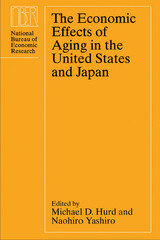 The Economic Effects of Aging in the United States and Japan
Edited by Michael D. Hurd and Naohiro Yashiro
University of Chicago Press, 1997 Due to falling fertility rates, the aging of the baby-boom cohort, and increases in life expectancy, the percentage of the population that is elderly is expected to increase rapidly in the United States and Japan over the next two decades. These fourteen essays show that, despite differences in culture and social and government structure, population aging will have many similar macro and micro effects on the economic status and behavior of the elderly in both countries.
The most obvious effects will be on social programs such as public pension systems and the provision for medical needs of the elderly. But, the contributors demonstrate, aging will also affect markets for labor, capital, housing, and health care services. It will affect firms through their participation in the demand side of the labor market and through their provisions for pensions. And aging will influence saving rates, the rate of return on assets, the balance of payments, and, most likely, economic growth.
This volume will interest scholars and policy makers concerned with the economics of aging.
 Economic Engagements with Art, Volume 31
Craufurd D. W. Goodwin and Neil de Marchi, eds.
Duke University Press Historically, economists have had very little to say about art: in the latter half of this century, that has begun to change. Difficult issues, like pricing and art valuation, the influence on pricing by what is fashionable in art, and the nature of the auction, have recently been tackled by economists in spite of elusive answers. Economic Engagements with Art suggests that taste and fashion in art need not be mysterious or outside rational discourse, and that they can be studied by economists to the great benefit of the discipline.
This volume, which deals mostly with painting, is divided into three sections that consider the interplay between art and economics from different perspectives. In the first section, Art and Economic Theory, economists clarify the need to construct a framework for understanding the roles of taste and fashion in art valuation. A historical view is considered in a piece about the teacher of Velasquez and artistic adviser to the Inquisition in Seville, who took into account not only market factors, like demand, but also the "truth" and the nobility of the artist’s profession and of the painting itself. Also in this section is an essay on Rousseau’s perspective on the worth of a painting based on its envy value in social circles; other contributions focus on William Stanley Jevons, a nineteenth century British political economist, whose problems with art stemmed from the uniqueness of each work, rendering definitive market and economic terms irrelevant. The second section of the book, Art and Economic Policy, looks at broader policy issues with regard to the historical role of art. Essays consider policy with respect to art exports and imports and federal patronage of the arts during theDepression; Lionel Robbins and the political economy of art; and the interplay among economy, architecture, and politics as shown in certain postwar Hilton hotels. In the final section, The Business of Art, a variety of perspectives are considered: the economics of art in early modern times, discussed in the context of both humanist and scholastic approaches; the pricing of pictures based on a study of the Smith-Reynolds connection; and the relationships between Otto Nuerath, graphic art, and the social order.
The first collaborative and historical treatment of the connection between art and economics, Economic Engagements with Art will appeal to people across, from history and economics to art history.
Contributors. Márcia Balisciano, William J. Barber, Neil de Marchi, Bertil Fridén, Crauford D. Goodwin, Guido Guerzoni, Robert J. Leonard, Harro Maas, Ernest Mathijs, Steven G. Medema, Bert Mosselmans, Zarinés Negrón, Marcia Pointon, Helen Rees, Toon van Houdt, Annabel Wharton, Sara Zablotney
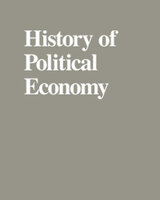 Economic Engagements with Art, Volume 31
Craufurd D. W. Goodwin and Neil de Marchi, eds.
Duke University Press Historically, economists have had very little to say about art: in the latter half of this century, that has begun to change. Difficult issues, like pricing and art valuation, the influence on pricing by what is fashionable in art, and the nature of the auction, have recently been tackled by economists in spite of elusive answers. Economic Engagements with Art suggests that taste and fashion in art need not be mysterious or outside rational discourse, and that they can be studied by economists to the great benefit of the discipline.
This volume, which deals mostly with painting, is divided into three sections that consider the interplay between art and economics from different perspectives. In the first section, Art and Economic Theory, economists clarify the need to construct a framework for understanding the roles of taste and fashion in art valuation. A historical view is considered in a piece about the teacher of Velasquez and artistic adviser to the Inquisition in Seville, who took into account not only market factors, like demand, but also the "truth" and the nobility of the artist’s profession and of the painting itself. Also in this section is an essay on Rousseau’s perspective on the worth of a painting based on its envy value in social circles; other contributions focus on William Stanley Jevons, a nineteenth century British political economist, whose problems with art stemmed from the uniqueness of each work, rendering definitive market and economic terms irrelevant. The second section of the book, Art and Economic Policy, looks at broader policy issues with regard to the historical role of art. Essays consider policy with respect to art exports and imports and federal patronage of the arts during theDepression; Lionel Robbins and the political economy of art; and the interplay among economy, architecture, and politics as shown in certain postwar Hilton hotels. In the final section, The Business of Art, a variety of perspectives are considered: the economics of art in early modern times, discussed in the context of both humanist and scholastic approaches; the pricing of pictures based on a study of the Smith-Reynolds connection; and the relationships between Otto Nuerath, graphic art, and the social order.
The first collaborative and historical treatment of the connection between art and economics, Economic Engagements with Art will appeal to people across, from history and economics to art history.
Contributors. Márcia Balisciano, William J. Barber, Neil de Marchi, Bertil Fridén, Crauford D. Goodwin, Guido Guerzoni, Robert J. Leonard, Harro Maas, Ernest Mathijs, Steven G. Medema, Bert Mosselmans, Zarinés Negrón, Marcia Pointon, Helen Rees, Toon van Houdt, Annabel Wharton, Sara Zablotney
Economic Evaluation of Projects in the Electricity Supply Industry
Hisham Khatib
The Institution of Engineering and Technology, 2003 In the highly capital-intensive electricity supply industry, it is essential that both engineers and managers understand the methodologies of project evaluation in order to comprehend and analyse investment proposals and decisions. This fully revised and updated edition of Economic Evaluation of Projects in the Electricity Supply Industry (1996) takes a broad introductory approach, covering market and environmental issues, financial analysis and evaluation, and clean environmental technologies and costs. New topics include electricity trading and risk management, evolving electricity utilities and new and future generation technologies in a carbon-constrained world.
Economic Evaluation of Projects in the Electricity Supply Industry
Hisham Khatib
The Institution of Engineering and Technology, 2014 In the highly capital-intensive electricity supply industry, it is essential that both engineers and managers understand the methodologies of project evaluation in order to comprehend and analyse investment proposals and decisions. This updated and expanded edition of Economic Evaluation of Projects in the Electricity Supply Industry takes a broad introductory approach, covering planning and investment, financial analysis and evaluation, risk management, electricity trading, and strategies, technologies, national requirements and global agreements for electricity generation in a carbon-constrained world.
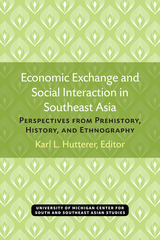 Economic Exchange and Social Interaction in Southeast Asia: Perspectives from Prehistory, History, and Ethnography
Karl L. Hutterer, Editor
University of Michigan Press, 1978 Economic behavior is governed by two major sets of boundary conditions: environmental and technological factors on the one hand, and conditions of social organization on the other hand. Indeed, social scientists are often particularly interested in the framework of exchange relationships: exchange of goods, services, personnel, and information. Economic exchanges lend concrete manifestations to social relations that themselves may transcend the economic realm and that otherwise are often difficult to trace.
Yet in social science research in Southeast Asia, the area of economic studies has lagged behind, despite the great study potential represented by the tremendous diversity of its physical and human environment. Economic Exchange and Social Interaction in Southeast Asia attempts to take advantage of that opportunity. As a number of the contributions to this volume show, many if not most of the systems organized on very different levels of integration interact with each other. Taken as a whole, they provide evidence of the incredible diversity of economic and social systems that may be investigated in Southeast Asia.
Economic Factors in the Growth of Corporate Giving
Ralph Lowell Nelson
Russell Sage Foundation, 1970 Examines the dramatic changes in the philanthropic behavior of business corporations in their support of education, health, welfare, and the arts. This analysis shows how traditional patterns of corporate philanthropy have undergone changes across the years, and how, presently, a favorable attitude exists toward giving. The author traces these shifts through periods of depression, war, and peace. He examines economic and non-economic reasons for the growth of corporate giving, and treats the innovative role of company-sponsored foundations.
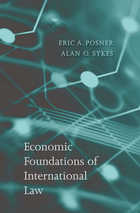 Economic Foundations of International Law
Eric A. Posner and Alan O. Sykes
Harvard University Press, 2012 The ever-increasing exchange of goods and ideas among nations, as well as cross-border pollution, global warming, and international crime, pose urgent questions for international law. Here, two respected scholars provide an intellectual framework for assessing these pressing legal problems from a rational choice perspective.
The approach assumes that states are rational, forward-looking agents which use international law to address the actions of other states that may have consequences for their own citizens, and to obtain the benefits of international cooperation. It further assumes that in the absence of a central enforcement agency—that is, a world government—international law must be self-enforcing. States must believe that if they violate international agreements, other states will retaliate.
Consequently, Eric A. Posner and Alan O. Sykes devote considerable attention to the challenges of enforcing international law, which begin with the difficulties of determining what it is. In the absence of an international constitution, the sources for international law are vague. Lawyers must rely on statements contained in all manner of official documents and on simple observation of states’ behavior. This looseness leads international institutions such as the United Nations to deliver conflicting interpretations of the law’s most basic principles. The authors describe the conditions under which international law succeeds or fails, across a wide range of issues, including war crimes, human rights, international criminal law, principles of state responsibility, law of the sea, international trade regulation, and international investment law.
 Economic Growth of Nations: Total Output and Production Structure
Simon Kuznets
Harvard University Press, 1971 In the seven chapters presented here noted economist and Nobel Prize–winner Simon Kuznets summarizes the results of his studies of the economic growth of nations in modern times. Working over the last twenty years, he has concerned himself largely with national product and its components—with long-term trends in growth in total output and in labor force changes in production structure. Such comprehensive data, Kuznets maintains, in which significantly different elements are distinguished and measured, are indispensable both for observations and analysis of the essentially quantitative process of economic growth and for the search for the general and variant characteristics of this growth. He covers a variety of countries and is able to suggest valid general characteristics and test the limits within which they hold. He also provides comparisons between the economically developed and the less developed countries and evaluates the relation between per capita product and the structure of production and the movements of both over time in the course of modern economic growth.
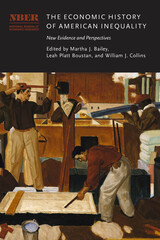 The Economic History of American Inequality: New Evidence and Perspectives
Edited by Martha J. Bailey, Leah Platt Boustan, and William J. Collins
University of Chicago Press, 2025 A meticulous examination of the history and roots of economic inequality within the United States. This volume refines and extends the economic history literature on economic inequality in the United States. Economic inequality manifests itself on various dimensions, including access to resources and economic security, as well as access to education and opportunities for migration, marriage, and other important life decisions. Measuring inequality and studying its variation over time and in response to economic shocks such as recessions and wars deepen our understanding of how the economy operates and can inform the design of public policies. The studies in this compendium present comprehensive evidence on income distribution during the nineteenth and early twentieth centuries, drawing on new data on wages and prices. They also consider disparities in economic well-being that are reflected in outcomes other than wage and salary income, such as homeownership and marriage. The volume also presents new evidence on the effects of income inequality on social outcomes. It concludes with an intellectual history of “human capital,” a core concept in the economic analysis of the underpinnings of labor market inequality.
The Economic History of Byzantium
Angeliki E. Laiou
Harvard University Press, 2002 The longevity of the Byzantine state was due largely to the existence of variegated and articulated economic systems. This three-volume study examines the structures and dynamics of the economy and the factors that contributed to its development over time. The first volume addresses the environment, resources, communications, and production techniques. The second volume examines the urban economy; presents case studies of a number of places, including Sardis, Pergamon, Thebes, Athens, and Corinth; and discusses exchange, trade, and market forces. The third volume treats the themes of economic institutions and the state and general traits of the Byzantine economy. This global study of one of the most successful medieval economies will interest historians, economic historians, archaeologists, and art historians, as well as those interested in the Byzantine Empire and the medieval Mediterranean world.
An Economic History of Sweden
Eli Filip Heckscher
Harvard University Press Long respected as a classic in Europe, this translation is welcomed as the first comprehensive survey of Swedish economic history available in this country. Herein the late Eli Filip Heckscher discusses Swedish economy from the feudalism of the Middle Ages to World War II socialism.
Complete coverage is given to such diverse yet interrelated subjects as land distribution and use, agrarian reforms, growth of cities, social structure, foreign influence and immigration, development of iron and other metals, forest industry, population growth, trade beginnings, cooperatives, and the growth of socialism.
Faithfully translated, and with a newly added conclusion by Gunnar Heckscher, the author's son, this interesting book is valuable as a study of one of Europe's most economically advanced countries. Well-illustrated with maps, charts, and graphs, it provides invaluable reference material.
 Economic Imperative Ethical Values: South African Experience & Int'L Codes
S. Prakash Sethi
University of Notre Dame Press, 2001 "A major academic contribution to our understanding of the economic, social, moral, and political forces that swirled around the international campaign to end the policy of apartheid in South Africa. I rank this book among the top scholarly studies of the topic."--James E. Post, Professor of Management, Boston University
"For those interested in learning how to convert mistakes of the past into positive initiatives for the future, this book is a ‘must read'."--Global Focus
"A monumental achievement . . ."--The Christian Century Economic Imperatives and Ethical Values in Global Business offers an in-depth and systematic analysis of the workings of the Sullivan Principles and their impact on the interactions of foreign corporations with South Africa. Published for the first time in the United States, this book interprets how the experience of the Sullivan Principles might instruct the process of developing codes of ethics as large multinational corporations cope with issues of human rights, living and working conditions of workers, environmental protection, and sustainable growth in their overseas manufacturing operations.
S. PRAKASH SETHI is university distinguished professor, academic director of executive programs, and professor of management at the Zicklin School of Business, Baruch College, The City University of New York. Sethi has published 23 books and more than 130 articles. He is currently the chairperson of the Mattel Independent Monitoring Council for Mattel Corporation's Global Manufacturing Principles.
OLIVER F. WILLIAMS, C.S.C., is associate professor of management in the Mendoza School of Business and academic director of the Center for Ethics and Religious Values in Business at the University of Notre Dame. He also teaches in South Africa at the University of Cape Town and Stellenbosch University. Williams is editor of Moral Imagination and Global Codes of Conduct, both published by the University of Notre Dame Press.
----------
"This comprehensive book, breathtaking in scope and detail concerning the Sullivan Principles and derivative lessons, is a "must read" for corporate and policy practitioners and scholars interested in the manifold and ever-changing issues of multinational corporate social responsibilities in the global political economy of the twenty-first century. We owe a debt of thanks to the authors for focusing our attention on this inexhaustible issue in the context of arguably the most intractable situation the international business community had to deal with in the last part of the twentieth century. This is truly an important book!" --Business & Society, 2001
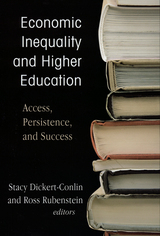 Economic Inequality and Higher Education: Access, Persistence, and Success
Stacy Dickert-Conlin
Russell Sage Foundation, 2007 The vast disparities in college attendance and graduation rates between students from different class backgrounds is a growing social concern. Economic Inequality and Higher Education investigates the connection between income inequality and unequal access to higher education, and proposes solutions that the state and federal governments and schools themselves can undertake to make college accessible to students from all backgrounds. Economic Inequality and Higher Education convenes experts from the fields of education, economics, and public policy to assess the barriers that prevent low-income students from completing college. For many students from disadvantaged socioeconomic backgrounds, the challenge isn't getting into college, but getting out with a degree. Helping this group will require improving the quality of education in the community colleges and lower-tier public universities they are most likely to attend. Documenting the extensive disjuncture between the content of state-mandated high school testing and college placement exams, Michael Kirst calls for greater alignment between K-12 and college education. Amanda Pallais and Sarah Turner examine barriers to access at elite universities for low-income students—including tuition costs, lack of information, and poor high school records—as well as recent initiatives to increase socioeconomic diversity at private and public universities. Top private universities have increased the level and transparency of financial aid, while elite public universities have focused on outreach, mentoring, and counseling, and both sets of reforms show signs of success. Ron Ehrenberg notes that financial aid policies in both public and private universities have recently shifted towards merit-based aid, away from the need-based aid that is most helpful to low-income students. Ehrenberg calls on government policy makers to create incentives for colleges to increase their representation of low-income students. Higher education is often vaunted as the primary engine of upward mobility. Instead, as inequality in America rises, colleges may be reproducing income disparities from one generation to the next. Economic Inequality and Higher Education illuminates this worrisome trend and suggests reforms that educational institutions and the government must implement to make the dream of a college degree a reality for all motivated students.
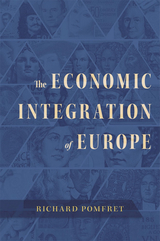 The Economic Integration of Europe
Richard Pomfret
Harvard University Press, 2021 The clearest and most up-to-date account of the achievements—and setbacks—of the European Union since 1945.
Europe has been transformed since the Second World War. No longer a checkerboard of entirely sovereign states, the continent has become the largest single-market area in the world, with most of its members ceding certain economic and political powers to the central government of the European Union. This shift is the product of world-historical change, but the process is not well understood. The changes came in fits and starts. There was no single blueprint for reform; rather, the EU is the result of endless political turmoil and dazzling bureaucratic gymnastics. As Brexit demonstrates, there are occasional steps backward, too. Cutting through the complexity, Richard Pomfret presents a uniquely clear and comprehensive analysis of an incredible achievement in economic cooperation.
The Economic Integration of Europe follows all the major steps in the creation of the single market since the postwar establishment of the European Coal and Steel Community. Pomfret identifies four stages of development: the creation of a customs union, the deepening of economic union with the Single Market, the years of monetary union and eastward expansion, and, finally, problems of consolidation. Throughout, he details the economic benefits, costs, and controversies associated with each step in the evolution of the EU. What lies ahead? Pomfret concludes that, for all its problems, Europe has grown more prosperous from integration and is likely to increase its power on the global stage.
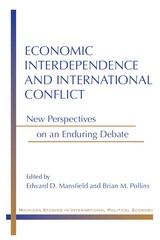 Economic Interdependence and International Conflict: New Perspectives on an Enduring Debate
Edward D. Mansfield and Brian M. Pollins, Editors
University of Michigan Press, 2003 The claim that open trade promotes peace has sparked heated debate among scholars and policymakers for centuries. Until recently, however, this claim remained untested and largely unexplored. Economic Interdependence and International Conflict clarifies the state of current knowledge about the effects of foreign commerce on political-military relations and identifies the avenues of new research needed to improve our understanding of this relationship. The contributions to this volume offer crucial insights into the political economy of national security, the causes of war, and the politics of global economic relations.
Edward D. Mansfield is Hum Rosen Professor of Political Science and Co-Director of the Christopher H. Browne Center for International Politics at the University of Pennsylvania.
Brian M. Pollins is Associate Professor of Political Science at Ohio State University and a Research Fellow at the Mershon Center.
Economic Knowledge in Socialism, 1945–1989
Till Düppe and Ivan Boldyrev, special issue editors
Duke University Press This cross-disciplinary special issue focuses on economic knowledge in social countries during the second half of the twentieth century. Through a series of historical case studies, the issue embraces a wide variety of perspectives on the ways economy and society were conceptualized behind the Iron Curtain. Contributors explored the entanglement of ideology and economic discourse, the political dimensions of cybernetic technocracy, and the various faces of Cold War rationality of socialism.
Contributors. Oleg Ananyin, Johanna Bockman, Ivan Boldyrev, Till Düppe, Richard Ericson, Yakov Feygin, Olessia Kirtchik, Martha Lampland, Adam Leeds, Denis Melnik, Chris Miller, György Peteri, Eglė Rindzevičiūtė, Vítězslav Sommer, Joachim Zweynert
 Economic Losses from Marine Pollution: A Handbook For Assessment
Douglas D. Ofiara and Joseph J. Seneca
Island Press, 2001 Marine pollution causes significant damage to fisheries and other economically productive uses of the ocean. The value of that damage can be quantified by economists, but the meanings of those valuations and how they are derived are often obscure to noneconomists.Economic Losses from Marine Pollution brings a fuller understanding of the variety and extent of marine losses and how they are assessed to scientists, lawyers, and environmentalists by systematically identifying and classifying marine losses and relating them to models and methods of economic valuation. The authors use a step-by-step approach to show how economists have used these methods and how they approach the problem of assessing economic damage.The book begins by describing the importance of economic valuation of marine damages, the history of concern over marine pollution, and the development of economic methodologies to assess damage from it. Following that, the book: considers types of marine pollution and their effects on organisms, ecosystems, and humans, and the corresponding economic effects of those biological impacts introduces the economic principles and methods needed to understand and to assess economic damages expresses losses from water quality impairments in terms of economic value introduces the basic economic techniques that have been developed and used to measure changes in economic value discusses how to apply those economic techniques, and presents a variety of practical examples explores limitations and problems that can arise in such applied work.Economic Losses from Marine Pollution includes all of the relevant economic theory together with specific examples of how that theory has been and can be applied. It offers environmental professionals with little or no background in economics the basic economic tools needed to understand economic valuations of environmental damage, and represents a unique handbook for environmental and marine scientists, lawyers, economists, policy professionals, and anyone interested in issues of marine water quality.
 Economic Maturity and Entrepreneurial Decline: British Iron and Steel, 1870-1913
Donald N. McCloskey
Harvard University Press, 1973 It is often alleged that late Victorian businessmen in Britain displayed little of the vigor of their fathers in competition with the new industrial powers of the late nineteenth century, Germany and the United States. This allegation has been the foundation for a great many interpretations of the end of British domination over the world's economic life and of the economic difficulties that Britain has faced subsequently.
The British iron and steel industry is taken traditionally as the prime example of entrepreneurial decline. Mr. McCloskey shows, however, that businessmen in the industry performed on most counts as well as their German and American counterparts. The lack of evidence of entrepreneurial failure in the industry casts serious doubt on the importance of the entrepreneurial factor in Britain's relative decline. It suggests, indeed, that the supposed failure was a mere reflex of Britain's early attainment of economic maturity and the contemporaneous drive to maturity of Germany and the United States.
McCloskey uses relatively uncomplicated economic tools to establish these points. The central tool is the measurement of total factor productivity in the iron and steel industry in Britain and abroad. It is supplemented by analyses of supply and demand (to remove the influence of slowly growing demand at home from the record of the British industry): of the profitability of adopting the basic open hearth process of steelmaking (to show that the slowness of Britain to adopt it-which has been the keystone of the case for entrepreneurial failure-was economically rational); and of the competitiveness of the industry's markets (to validate use of these simple tools).
The book is based on a thorough study of the trade newspapers of the industry, its scientific journals, its statistical annuals, and the many reports of the British government and contemporary observers on its activities. It combines, therefore, the virtues of the "old" and the 'new" economic history. And although the book is historical, its conclusions are relevant to any study of economic growth past or present, in particular to the study of the role of entrepreneurship.
This book, a revision of Mr. McCloskey's Ph.D. dissertation, was awarded the David A. Wells Prize for l970-7l. The author is Associate Professor of Economics, The University of Chicago.
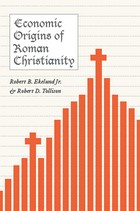 Economic Origins of Roman Christianity
Robert B. Ekelund Jr. and Robert D. Tollison
University of Chicago Press, 2011 In the global marketplace of ideas, few realms spark as much conflict as religion. For millions of people, it is an integral part of everyday life, reflected by a widely divergent supply of practices and philosophical perspectives. Yet, historically, the marketplace has not always been competitive. While the early Common Era saw competition between Christianity, Judaism, and the many pagan cults, Roman Christianity came eventually to dominate Western Europe. Using basic concepts of economic theory, Robert B. Ekelund Jr. and Robert D. Tollison explain the origin and subsequent spread of Roman Christianity, showing first how the standard concepts of risk, cost, and benefit can account for the demand for religion. Then, drawing on the economics of networking, entrepreneurship, and industrial organization, the book explains Christianity's rapid ascent. Like a business, the church developed sound business strategies that increased its market share to a near monopoly in the medieval period. This book offers a fascinating look at the dynamics of Christianity’s rise, as well as how aspects the church’s structure—developed over the first millennium—illuminate a number of critical problems faced by the church today.
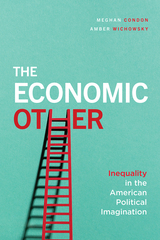 The Economic Other: Inequality in the American Political Imagination
Meghan Condon and Amber Wichowsky
University of Chicago Press, 2020 Economic inequality is at a record high in the United States, but public demand for redistribution is not rising with it. Meghan Condon and Amber Wichowsky show that this paradox and other mysteries about class and US politics can be solved through a focus on social comparison. Powerful currents compete to propel attention up or down—toward the rich or the poor—pulling politics along in the wake.
Through an astute blend of experiments, surveys, and descriptions people offer in their own words, The Economic Other reveals that when less-advantaged Americans compare with the rich, they become more accurate about their own status and want more from government. But American society is structured to prevent upward comparison. In an increasingly divided, anxious nation, opportunities to interact with the country’s richest are shrinking, and people prefer to compare to those below to feel secure. Even when comparison with the rich does occur, many lose confidence in their power to effect change.
Laying bare how social comparisons drive political attitudes, The Economic Other is an essential look at the stubborn plight of inequality and the measures needed to solve it.
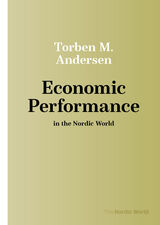 Economic Performance in the Nordic World
Torben M. Andersen
University of Wisconsin Press, 2021 The Nordic countries stand out in international comparisons for having both high living standards and low inequality. The welfare state and public sectors are large and the tax burden is high. How have these countries managed to achieve such favorable economic performance?
Economist Torben M. Andersen shows how the Nordic model rests on two pillars: the social safety net, which offers income compensation to the majority of those unable to support themselves, and the provision of services like education, childcare, and healthcare to all. The Nordic model can be characterized as one of employment, since its financial viability rests on a high labor participation rate with few working poor.
Andersen lays out the structure of the model and highlights factors important for understanding its economic performance. He then looks into specific policy areas based on Denmark's experiences regarding labor market policies (flexicurity), pension systems, and preparation for an aging population; and addresses the challenges arising from new technologies and globalization.
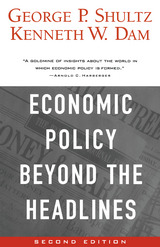 Economic Policy Beyond the Headlines
George P. Shultz and Kenneth W. Dam
University of Chicago Press, 1998 Drawing from their experience as government insiders, George P. Shultz and Kenneth W. Dam show how economic policy is shaped at the highest levels of government. They reveal the interconnections between economic, social, and international policy, covering issues such as the advocacy system and the role of the individual in shaping policy. A new chapter, 'A Changed World,' explores the various influences of our increasingly global economy on economic strategy. With rare candor, authority and breadth of vision, Shultz and Dam have produced a brilliant introduction to economic policy, its principles, and practice.
"A model of brevity and lucidity . . . [Economic Policy Beyond the Headlines] incorporates a unique and rewarding blend of economic reasoning with a high level of political awareness . . . enriched by the wide personal experience in government of the authors."—Albert T. Sommers, Across the Board
"[Shultz and Dam] help foreign readers to understand why the world looks so different from Washington. . . . This book should provide the model."—The Economist
"A wise and valuable book showing great insight into the realities of economic policy making."—Henry A. Kissinger
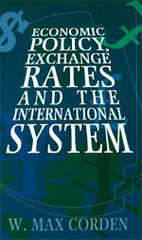 Economic Policy, Exchange Rates, and the International System
W. Max Corden
University of Chicago Press, 1994 An ambitious successor to W. Max Corden's highly acclaimed Inflation,
Exchange Rates, and the World Economy, this book addresses topics in
international macroeconomics that have come to the forefront of economic
policy debates in recent years. Covering exchange rate policy, the
European Monetary System, protection and competition, and the
international "non-system" since the collapse of Bretton Woods, Corden
provides a probing analysis of significant economic trends associated
with the increasing integration of the world capital market.
Beginning with essays on exchange rate policy, the current account, and
external effects of fiscal policy, Corden lays out the foundations of
balance-of-payments theory in relation to wage rates, income
distribution, and inflation. Chapters on the European Monetary System
focus on monetary integration and look skeptically at European proposals
to move toward monetary union. Other topical essays discuss the
"competitiveness" problem and the relation between protection and
macroeconomic policy.
Corden summarizes and clarifies a vast range of work on the coordination
of macroeconomic policies and critically reviews various proposals for
reforming the international monetary system.
Economic Policy Making in Mexico: Factors Underlying the 1982 Crisis
Robert Looney
Duke University Press, 1985 This volume argues that the Mexican crisis of August 1982, in which the country was left facing the prospect of national default and zero economic growth, was not only the result of some fundamental flaws in the country's economy, but is more accurately characterized as a cash flow problem—in the author's words, "a case of illiquidity rather than insolvency." Based on a thorough analysis of the Mexican economy, the book assesses the effectiveness of the various economic programs of the de la Madrid presidency in dealing with the nation's problems.
|
|
